|
|
MARDOQUEO/MARDUK ES TIPO DEL SANTO GRIAL-ESTER/ISTAR-EN BABILONIA ISTAR ERA MADRE DE MARDUK-BABILONIA/BABYLON


Puerta de Ishtar, Pergamonmuseum, Berlín
The Ishtar Gate from Babylon; Puerta de Istar; שער עשתר ; بوابة عشتار;
Three names that appear more often as a sacred group of three are … Ninki - (later became Ishtar) the mother Enki - (later became Namakh) the father Marduk the son
This Trinity representation evolved a little further. In the ancient ruins in Syria centuries later after the belief had been passed down many generations, long before The Christ, some names were altered for unknown reasons. Perhaps in the same way the name Yeshua, a Hebrew Aramaic name was altered to become Jesus, a more acceptable Roman name after someone of the authority like Emperor Constantine had altered it. The same three Sun gods from Sumer now as follows… from left to right… Marduk the son on a lion, Enki… now as Namakh the father still retaining the bull of Taurus, and Ninki… now as Ishtar on another lion.
254. Ester 2:19: Cuando las vírgenes eran reunidas la segunda vez, Mardoqueo estaba sentado a la PUERTA del rey.
255. Ester 2:21: En aquellos días, estando Mardoqueo sentado a la PUERTA del rey, se enojaron Bigtán y Teres, dos eunucos del rey, de la guardia de la PUERTA, y procuraban poner mano en el rey Asuero.
256. Ester 3:2: Y todos los siervos del rey que estaban a la PUERTA del rey se arrodillaban y se inclinaban ante Amán, porque así lo había mandado el rey; pero Mardoqueo ni se arrodillaba ni se humillaba.
257. Ester 3:3: Y los siervos del rey que estaban a la PUERTA preguntaron a Mardoqueo: ¿Por qué traspasas el mandamiento del rey?
258. Ester 4:2: Y vino hasta delante de la PUERTA del rey; pues no era lícito pasar adentro de la PUERTA del rey con vestido de cilicio.
259. Ester 4:6: Salió, pues, Hatac a ver a Mardoqueo, a la plaza de la ciudad, que estaba delante de la PUERTA del rey.
260. Ester 5:1: Aconteció que al tercer día se vistió Ester su vestido real, y entró en el patio interior de la casa del rey, enfrente del aposento del rey; y estaba el rey sentado en su trono en el aposento real, enfrente de la PUERTA del aposento.
261. Ester 5:9: Y salió Amán aquel día contento y alegre de corazón; pero cuando vio a Mardoqueo a la PUERTA del palacio del rey, que no se levantaba ni se movía de su lugar, se llenó de ira contra Mardoqueo.
262. Ester 5:13: Pero todo esto de nada me sirve cada vez que veo al judío Mardoqueo sentado a la PUERTA del rey.
263. Ester 6:2: Entonces hallaron escrito que Mardoqueo había denunciado el complot de Bigtán y de Teres, dos eunucos del rey, de la guardia de la PUERTA, que habían procurado poner mano en el rey Asuero.
264. Ester 6:10: Entonces el rey dijo a Amán: Date prisa, toma el vestido y el caballo, como tú has dicho, y hazlo así con el judío Mardoqueo, que se sienta a la PUERTA real; no omitas nada de todo lo que has dicho.
265. Ester 6:12: Después de esto Mardoqueo volvió a la PUERTA real, y Amán se dio prisa para irse a su casa, apesadumbrado y cubierta su cabeza.
GATE=33
G=7
A=1
T=20
E=5
7+1+20+5=33
HECHOS 12
486. Hechos 12:10: Habiendo pasado la primera y la segunda guardia, llegaron a la PUERTA de hierro que daba a la ciudad, la cual se les abrió por sí misma; y salidos, pasaron una calle, y luego el ángel se apartó de él.
12:11 Entonces Pedro, volviendo en sí, dijo: Ahora entiendo verdaderamente que el Señor ha enviado su ángel, y me ha librado de la mano de Herodes, y de todo lo que el pueblo de los judíos esperaba.
12:12 Y habiendo considerado esto, llegó a casa de María la madre de Juan, el que tenía por sobrenombre Marcos, donde muchos estaban reunidos orando.
487. Hechos 12:13: Cuando llamó Pedro a la PUERTA del patio, salió a escuchar una muchacha llamada Rode,
488. Hechos 12:14: la cual, cuando reconoció la voz de Pedro, de gozo no abrió la PUERTA, sino que corriendo adentro, dio la nueva de que Pedro estaba a la PUERTA.
GATE/PUERTA
HECHOS 12:12 (1+2:1+2/3:3)
| gate in Simple Gematria Equals: 33 |
( |
g
7 |
a
1 |
t
20 |
e
5 |
) |
12:12 Y habiendo considerado esto, llegó a casa de María la madre de Juan, el que tenía por sobrenombre Marcos, donde muchos estaban reunidos orando.
|
|
|
|
|
Sumerian Minor Gods and Goddesses
Ereshkigal
In Sumerian and Akkadian (Babylonian and Assyrian) mythology, Ereshkigal, wife of Nergal, was the goddess of Irkalla, the land of the dead. She managed the destiny of those who were beyond the grave, in the Underworld, where she was queen.
It was said that she had been stolen away by Kur and taken to the Underworld, where she was made queen unwillingly. She is actually the twin sister of Enki. Ereshkigal was the only one who could pass judgement and give laws in her kingdom, and her name means "Lady of the Great Place", "Lady of the Great Earth", or "Lady of the Great Below". Her main temples were at Kutha and Sippar.
Ereshkigal was also Inanna and Ishtar.
Inanna
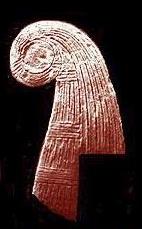 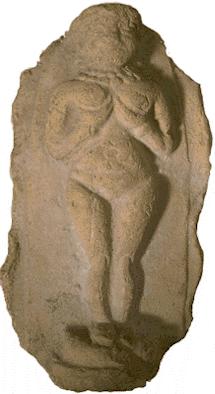 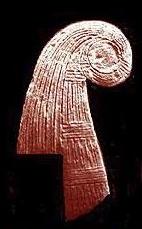
The goddess Inanna (Innin, or Innini) was the patron and special god/goddess of the ancient Sumerian city of Erech (Uruk), the City of Gilgamesh. As Queen of heaven, she was associated with the Evening Star (the planet Venus), and sometimes with the Moon. She may also have been associated the brightest stars in the heavens, as she is sometimes symbolized by an eight-pointed star, a seven-pointed star, or a four pointed star. In the earliest traditions, Inanna was the daughter of An, the Sky, Ki, the Earth (both of Uruk, (Warka)). In later Sumerian traditions, she is the daughter of Nanna (Narrar), the Moon God and Ningal, the Moon Goddess (both of Ur).
On either side of her cult statue shown above is the ring-post, also known as Inanna's knot. This was a sacred symbol of Inanna, associated exclusively with her. It represents a door-post made from a bundle of reeds, the upper ends, bent into a loop to hold a cross-pole. The ring-post is shown on many depictions of Inanna, including those of the famed Warka Vase.
Inanna
Owl - Eye Symbology
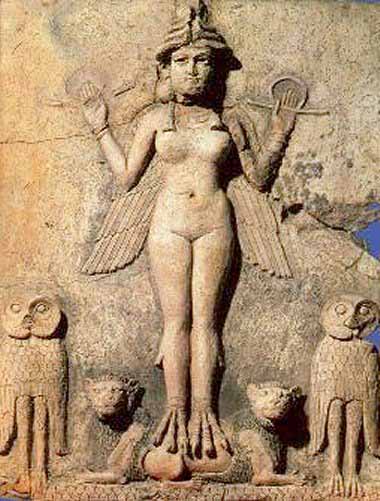
Wings - Evolution of Consciousness in the Alchemy of Time
Palms - Jesus - Holding Omega - Endings - Leo - Lion
Twin Lions - Breast of the Sphinx

Inanna was one of the most revered of goddesses among later Sumerian mythology.
Inanna's Descent
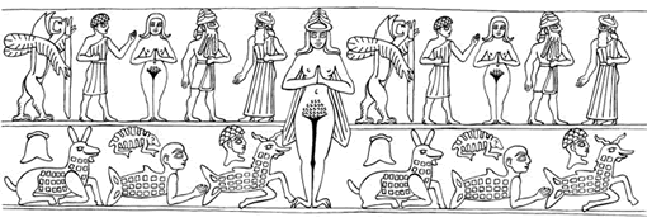
A winged goddess wearing a multi-horned crown stands with her head in the realm of the deities and their devotees. Her bird-clawed feet rest in a place, likely the underworld, inhabited by strange and demonic creatures. This shows the duality of her nature - as well as our own - above and below. Some think her to be Lilith, but the crown shows her to be a great goddess, almost certainly Inanna. Mesopotamian cylinder seal. Hematite. 2000-1600 BCE.
She was said to descend from the ancient family of the creator goddess Nammu, who was her grandmother. Inanna held "full power of judgment and decision and the control of the law of heaven and earth." Her sacred planet was Venus, the evening star. She was often symbolized as a lioness in battle. Along the Tigris and Euphrates rivers were many shrines and temples dedicated to Inanna.
The temple of E Anna, Inanna's House of Heaven, in Uruk, was the greatest of these. This temple was 5000 years old and had been built and rebuilt many times to hold a community of sacred women who cared for the temple lands. The high priestess of Inanna would choose for her bed one she would appoint as shepherd. He would represent Dumuzi, sacred son/lover of Inanna, if he could prove his worth.
In later times, Inanna's lost some of her attributes, which were then said then to have been given her by Enki, rather than by her grandmother Nammu and her mother Ningal.
The myth states that Inanna traveled to Eridu and was given the one hundred Mes, which were the gifts of culture such as truth and justice, as well as practical skills such as weaving and pottery-making. Though Enki regretted his drunken decision to release the Mes to her and sent mighty sea monsters to stop her boat as it sailed the Euphrates, she was able to defeat them and bring the knowledge back to Uruk.
Inanna and Dumuzi
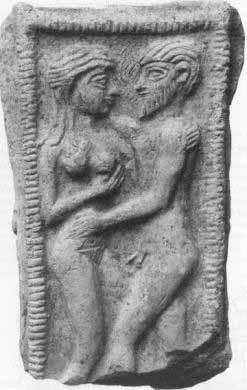

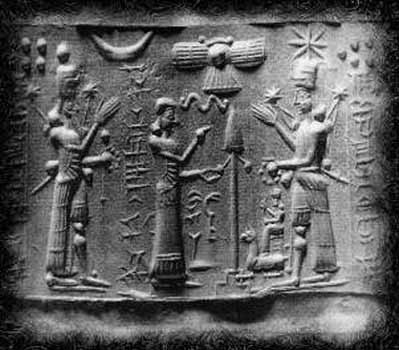
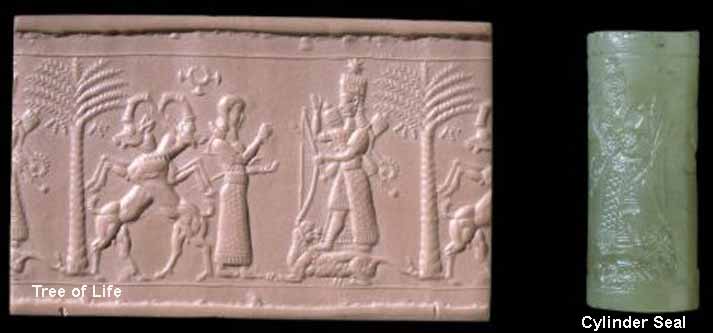
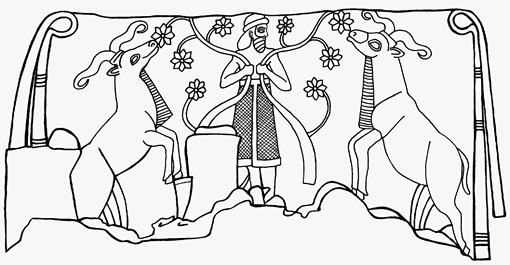
Dumuzi in net skirt (symbolizes grids) feeding sheep.
Inanna's standards ("gateposts") that frame the image suggest
that the event is happening inside her temple grounds.
Mesopotamian cylinder seal. Marble. About 3200-3000 BCE.
Dumuzi
Tammuz or Tamuz - Sumerian Dumuzi - was the name of a Babylonian deity. In Babylonia, the month Tammuz was established in honor of the eponymous god Tammuz, who originated as a Sumerian shepherd-god, Dumuzid or Dumuzi, the consort of Inanna and in his Akkadian form the parallel of Ishtar's consort, the Syrian Adonis who was drawn into the Greek pantheon. The name "Tammuz" seems to have been derived from the Akkadian form Tammuzi, based on early Sumerian Damu-zid. The later standard Sumerian form, Dumu-zid, in turn became Dumuzi in Akkadian. Beginning with the summer solstice came a time of mourning in the Ancient Near East as in the Aegean: the Babylonians marked the decline in daylight hours and the onset of killing summer heat and drought with a six-day "funeral" for the god, which was observed even at the very door of the Temple in Jerusalem, to the horror of the reformer Ezekiel.
The Myth
In the Sumerian King List Dumuzid the Fisherman appears as "Dumuzi the Fisherman, whose city was Kua, reigned 100 years" the third king of the first dynasty of Uruk (Dumuzi is likely Tammuzh or Tamizhi - a Pandyan king of ancient Tamil Nadu in South India,with his capital at Kuadam, his emblem as "fish"="min"), reigning between Lugalbanda and Gilgamesh the son of Lugalbanda, a situation not explained in extant texts. Nor is it explained why in other texts Dumuzid is always a shepherd, not a fisherman. The king list does list a Dumuzid the shepherd the fifth of the kings who reigned in Eridu before the flood. But Eridu, surrounded by freshwater marshes, is exactly where one would expect a fisherman and not a shepherd.
In any case a number of pastoral poems and songs relate the love affair of Inana and Dumuzid the shepherd. A text recovered in 1963 recounts "The Courtship of Inanna and Dumuzi" in terms that are tender and frankly erotic.
|
|
|
|
|
Then Inana (Ishtar in the Akkadian texts) set off for the netherworld, for Kur, which was ruled by her sister Ereshkigal, perhaps to take it as her own. Inana/Ishtar passed through seven gates and at each one was required to leave a garment or an ornament so that when Inana/Ishtar had passed through the seventh gate she was entirely naked. Despite warnings about her presumption, Inana/Ishtar did not turn back but dared to sit herself down on Ereshkigal's throne. Immediately the Anunnaki of the underworld judged her, gazed at her with the eyes of death, and Inana/Ishtar became a corpse, hung up on a hook.
Inana's faithful servant attempted to get help from the other gods but only wise Enki/Ea responded. The details of Enki/Ea's plan differ slightly in the two surviving accounts but the end is that Inana/Ishtar lived again. But a "conservation of souls" law required her to find a replacement for herself in Kur. She went from one god to another, but each one pleaded with her and she had not the heart to go through with it until she found Dumuzid/Tammuz on her throne, apparently quite pleased that she was gone. Inana/Ishtar immediately set the demons on Dumuzid/Tammuz. At this point the Akkadian text fails as Tammuz' sister Belili, introduced for the first time, strips herself of her jewelry in mourning but claims that Tammuz and the dead will come back.
There is some confusion here. The name Belili occurs in one of the Sumerian texts also, but it is not the name of Dumuzid's sister who is there named Geshtinana, but is the name of an old woman whom another text calls Bilulu.In any case, the Sumerian texts relate how Dumuzid fled to his sister Geshtinana who attempted to hide him but who could not in the end stand up to the demons. Dumuzid has one close call after another until the demons finally catch up with him under the supposed protection of this old woman called Bilulu or Belili and then they take him. However Inana repents.
Inana seeks vengeance on Bilulu, on Bilulu's murderous son Girgire and on Girgire's consort Shirru "of the haunted desert, no-one's child and no-one's friend". Inana changes Bilulu into a waterskin and Girgire into a protective god of the desert while Shirru is assigned to watch always that the proper rites are performed for protection against the hazards of the desert.
Finally, Inanna relents and changes her decree thereby restoring her husband Dumuzi to life; an arrangement is made by which Geshtinana will take Dumuzid's place in Kur for 6 months of the year.
Dumuzid/Tammuz being the god of the vegetation cycle, this corresponds to the changing of the seasons as the abundance of the earth diminishes in his absence. He is a life-death-rebirth deity.
An older interpretation
Based on the texts first found, it was assumed that Ishtar/Inana's descent into Kur occurred after the death of Tammuz/Dumuzid rather than before and that her purpose was to rescue Tammuz/Dumuzid. This is the familiar form of the myth as it appeared in M. Jastrow's "Descent of the Goddess Ishtar into the Lower World", 1915, widely available on the Internet.
Though new texts uncovered in 1963 filled in the story in quite another fashion, the old interpretation still lingers on. Aside from the extended epic "The Descent of Inanna," a previously unknown "Courtship of Inanna and Dumuzi," was first translated into English and annotated by Sumerian scholar Noah Kramer and folklorist Diane Wolkstein working in tandem, and published in 1983 (Kramer and Wolkstein 1983). Inanna's lover, the shepherd-king Dumuzi, brought a wedding gift of milk in pails, yoked across his shoulders.
The myth of Inanna and Dumuzi formed the subject of a Lindisfarne Symposium, published as The Story of Inanna and Dumuzi: From Folk-Tale to Civilized Literature: A Lindisfarne Symposium, (William Irwin Thompson, 1995).
Probably the most important Sumerian contribution to civilization was the invention and creation of a standard writing and literature; the Sumerians also had libraries. Their literary works reveal religious beliefs, ethical ideas, and the spiritual aspirations of the Sumerians. Among these works are the hymns and stories of Inanna -- important here because they were recorded at a time when the patriarchy was beginning to take hold, and the position of the Goddess, although strong, was changing.
She presented the me by Enki. The me is the order out of chaos, the great attributes of civilization, the powers of the gods. The me were conferred by the gods on other gods or on the king-priests, who as the representatives of the gods on Earth, ensured the continuation of civilization.
The special powers, contained within the me allowed the holy plan or design (the gis-hur) to be implemented on Earth. The me were contained within special objects of great sacred value, such as the royal throne, the sacred bed, the temple drum, the scepter, the crown, and other special articles of clothing or jewelry to be worn, sat on, lied in, and so forth. These things were charmed like a talisman. Inanna got Enki drunk on beer and tricked him into giving her the me. They gave her many special gifts and powers. She became Goddess and Queen of Heaven and Earth, now able to descend into the Underworld and ascend once again.
Inanna was the Queen of Beasts
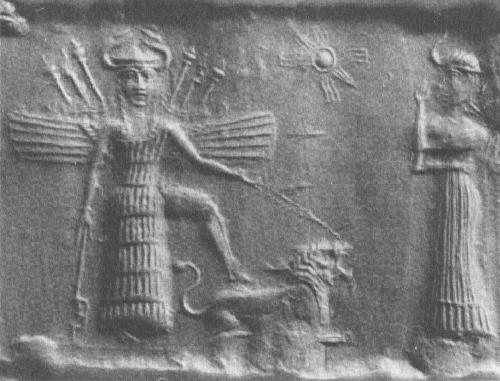
The Lion was her sacred animal
Inanna could be wily and cunning. She was a powerful warrior, who drove a war chariot, drawn by lions. In the duality of our reality she is portrayed as gentle and loving, a source of beauty and grace, a source of inspiration. She endowed the people of Sumer with gifts that inspired and insured their growth as a people and a culture. She is also depicted as a passionate, sensuous lover in The Courtship of Inanna and Damuzi, which established the principle of Sacred Marriage. Indeed, one aspect of Inanna is as the Goddess of Love, and it is in this aspect that she embodies creativity, procreativity, passion, raw sexual energy and power.
During the time the Goddess Inanna ruled the people of Sumer, they and their communities prospered and thrived. The urban culture, though agriculturally dependent, centered upon the reverence of the Goddess - a cella, or shrine, in her honor was the centerpiece of the cities. Inanna was the queen of seven temples throughout Sumer.
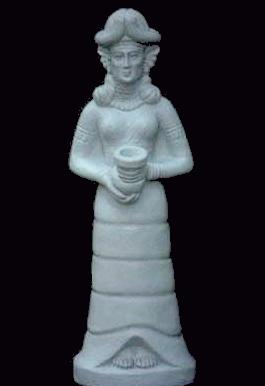
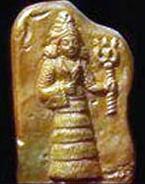
Erech or Uruk, near modern Warka was Inanna's sacred city. It was one of the oldest cities of Sumer. The Bible said that King Nimrod founded it. Dumuzi, Inanna's consort was a shepherd king of Uruk, as was Gilgamesh and his father Lugalbanda. The Temple of Inanna was in Erech. Also known as the E-ana or House of Heaven, this was her most important temple. The shrine of the Goddess was built on an artificial mound some forty feet above the ground level and was reached by a staircase. A statue of the Goddess was housed within the shrine.
Queen Shub-Ad reigned from the First Dynasty of Ur. Her grave was excavated by Sir Leonard Woolley of the British Museum in 1929. She was buried with her King in a vast tomb complex about 2900 BCE, with the accompaniment of what Woolley called "human sacrifice on a lavish scale," for along with the King and Queen, numerous male and female attendants, soldiers, grooms, handmaidens, ladies in waiting, etc. were also buried; even a harpist and her golden harp, inlayed with lapis. Chariots, carts, and their animals were also buried with them. The Queen wore the beautiful headdress of spirals of gold, terminating in lapis-centered gold flowers (or stars). The Queen also wore large golden earrings of lunate shape that hung to her shoulders; lapis amulets of a bull and a calf, and strands of lapis, agate, carnelian and gold beads. The Queen's grave was much more elaborate than that of the King, perhaps indicating her equal or even greater importance.
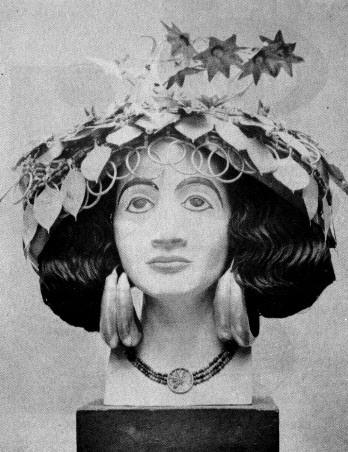
Inanna was Ishtar.
Ishtar
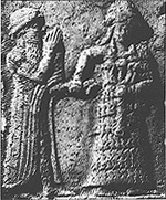
Ishtar is the Akkadian counterpart to the Sumerian Inanna and to the cognate northwest Semitic goddess Astarte. Anunit, Astarte and Atarsamain are alternative names for Ishtar. Inanna, twin of Utu/Shamash, children of Nannar/Sin, first born on Earth of Enlil. The first names given are Sumerian, the second names derive from the Akkadians, who are a Semitic people who immigrated into Sumeria. Adding an [sh] to a name is typical Akkadian, as Anu to Anush.
The goddess represents the planet Venus. (A continent on Venus is named Ishtar Terra by astronomers today.) The double aspect of the goddess may correspond to the difference between Venus as a morning star and as an evening star. In Sumerian the planet is called "MUL.DILI.PAT" meaning "unique star".
The name Inanna (sometimes spelled Inana) means "Great Lady of An", where An is the god of heaven. The meaning of Ishtar is not known, though it is possible that the underlying stem is the same as that of Assur, which would thus make her the "leading one" or "chief". In any event, it is now generally recognized that the name is Semitic in origin.
The Sumerian Inanna was first worshiped at Uruk (Erech in the Bible, Unug in Sumerian) in the earliest period of Mesopotamian history. In incantations, hymns, myths, epics, votive inscriptions, and historical annals, Inanna/Ishtar was celebrated and invoked as the force of life. But there were two aspects to this goddess of life. She was the goddess of fertility and sexuality, and could also destroy the fields and make the earth's creatures infertile. She was invoked as a goddess of war, battles, and the chase, particularly among the warlike Assyrians. Before the battle Ishtar would appear to the Assyrian army, clad in battle array and armed with bow and arrow. (compare Greek Athena.)
One of the most striking Sumerian myths describes Inanna passing through seven gates of hell into the underworld. At each gate some of her clothing and her ornaments are removed until at the last gate she is entirely naked. Ereshkigal, the queen of the underworld kills her and hangs her corpse on a hook on the wall. When Inanna returns from the underworld by intercession of the clever god, her uncle, Enki, according to the rules she must find someone to take her place. On her way home she encounters her friends prostrated with grief at her loss, but in Kulaba, her cult city, she finds her lover Dumuzi, a son of Enki, Tammuz seated in splendour on a throne, so she has him seized and dragged below. Later, missing him, she arranges for his sister to substitute for him during six months of the year.
In all the great centres Inanna and then Ishtar had her temples: E-anna, "house of An", in Uruk; E-makh, "great house", in Babylon; E-mash-mash, "house of offerings", in Nineveh. Inanna was the guardian of prostitutes, and probably had priestess-prostitutes to serve her. She was served by priests as well as by priestesses. The (later) votaries of Ishtar were virgins who, as long as they remained in her service, were not permitted to marry.
Inanna was also associated with beer, and was the patroness of tavern keepers, who were usually female in early Mesopotamia.
Ishtar is also an omnipresent figure in the epic of Gilgamesh. She appears also on the Uruk vase, one of the most famous ancient Mesopotamian artifacts. The relief on this vase seems to show Inanna conferring kingship on a supplicant. Various inscriptions and artifacts indicate that kingship was one of the gifts bestowed by Inanna on the ruler of Uruk.
On monuments and seal-cylinders Inanna/Ishtar appears frequently with bow and arrow, though also simply clad in long robes with a crown on her head and an eight-rayed star as her symbol. Statuettes have been found in large numbers representing her as naked with her arms folded across her breast or holding a child.
Together with the moon god Nanna or Suen (Sin in Akkadian), and the sun god Utu (Shamash in Akkadian), Inanna/Ishtar is the third figure in a triad deifying and personalizing the moon, the sun, and the earth: Moon (wisdom), Sun (justice) and Earth (life force). This triad overlies another: An, heaven; Enlil, earth; and Enki (Ea in Akkadian), the watery deep.
Symbol: an eight or sixteen-pointed star Sacred number: 15 Astrological region: Dibalt(Venus) and the Bowstar (Sirius) Sacred animal: lion, (dragon)
Ishtar Gate
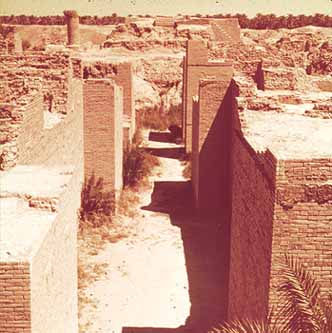
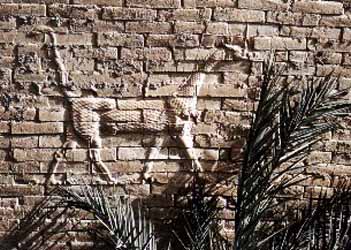
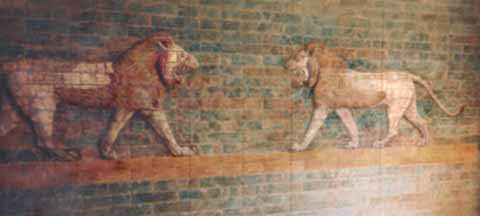
Marduk
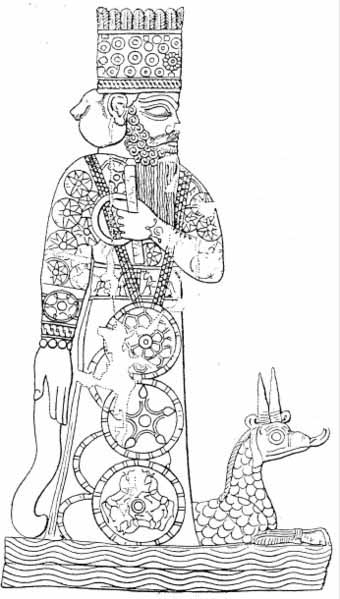
Marduk [mär'dook] (Sumerian spelling in Akkadian AMAR.UTU "solar calf"; Biblical Merodach) was the name of a late generation god from ancient Mesopotamia and patron deity of the city of Babylon, who, when Babylon permanently became the political center of the Euphrates valley in the time of Hammurabi (18th century BC), started to slowly rise to the position of the head of the Babylonian pantheon, position he fully acquired by the second half of the second millennium BCE.
|
|
|
|
|
Marduk's original character is obscure, but whatever special traits Marduk may have had were overshadowed by the reflex of the political development through which the Euphrates valley passed and which led to imbuing him with traits belonging to gods who at an earlier period were recognized as the heads of the pantheon.
There are more particularly two gods - Ea and Enlil - whose powers and attributes pass over to Marduk. In the case of Ea the transfer proceeds pacifically and without involving the effacement of the older god. Marduk is viewed as the son of Ea. The father voluntarily recognizes the superiority of the son and hands over to him the control of humanity. This association of Marduk and Ea, while indicating primarily the passing of the supremacy once enjoyed by Eridu to Babylon as a religious and political centre, may also reflect an early dependence of Babylon upon Eridu, not necessarily of a political character but, in view of the spread of culture in the Euphrates valley from the south to the north, the recognition of Eridu as the older centre on the part of the younger one.
While the relationship between Ea and Marduk is thus marked by harmony and an amicable abdication on the part of the father in favour of his son, Marduk's absorption of the power and prerogatives of Enlil of Nippur was at the expense of the latter's prestige. After the days of Hammurabi, the cult of Marduk eclipses that of Enlil, and although during the four centuries of Kassite control in Babylonia (c. 1570 BC1157 BC), Nippur and the cult of Enlil enjoyed a period of renaissance, when the reaction ensued it marked the definite and permanent triumph of Marduk over Enlil until the end of the Babylonian empire. The only serious rival to Marduk after ca. 1000 BC is Anshar in Assyria. In the south Marduk reigns supreme. He is normally referred to as Bel "Lord".
When Babylon became the capital of Mesopotamia, the patron deity of Babylon was elevated to the level of supreme god. In order to explain how Marduk seized power, Enûma Elish was written, which tells the story of Marduk's birth, heroic deeds, and becoming the ruler of the gods. This can be viewed as a form of Mesopotamian apologetics.
In Enûma Elish, a civil war between the gods was growing to a climatic battle. The Anunnaki gods gathered together to find one god who could defeat the gods rising against them. Marduk, a very young god, answered the call, and was promised the position of head god.When he killed his enemy he "wrested from him the Tablets of Destiny, wrongfully his" and assumed his new position. Under his reign humans were created to bear the burdens of life so the gods could be at leisure.
People were named after Marduk. For example, the Biblical personality Mordechai (Book of Esther) used this Gentile name in replacement of his Hebrew name Bilshan.Babylonian texts talk of the creation of Eridu by the god Marduk as the first city, 'the holy city, the dwelling of their [the other gods] delight'.
Nabu, god of wisdom, is a son of Marduk.
Etemenanki, "The temple of the creation of heaven and earth", was the name of a ziggurat to Marduk in the city of Babylon of the 6th century BC Chaldean (Neo-Babylonian) dynasty. Originally seven stories in height, little remains of it now save ruins. Etemenanki was later popularly identified with the Tower of Babel.
Nammu - Namma

In Sumerian mythology, Nammu (more properly Namma) is the Sumerian creation goddess. If the Babylonian creation myth Enûma Elish is based on a Sumerian myth, which seems likely, Nammu/Namma is the Sumerian goddess of the primeval sea that gave birth to heaven and earth and the first gods. She was probably the first personification of the constellation which the Babylonians later called Tiamat and the Greeks called Cetus and represented the Apsu, the fresh water ocean which the Sumerians believed lay beneath the earth, the source of life-giving water and fertility in a country with almost no rainfall.
As Nammu/Namma is the goddess of the fertile waters, An is the god of the sky. Nammu/Namma and her son Enki created mankind as assistants for the gods. Enki is the god of human culture who also presides over the Absu.
Nergal
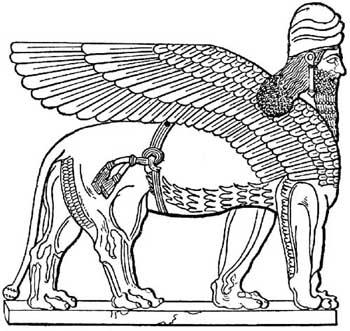
The name Nergal (or Nirgal, Nirgali) refers to a deity in Babylonia with the main seat of his cult at Cuthah (or Kutha) represented by the mound of Tell-Ibrahim. Nergal is mentioned in the Hebrew bible as the deity of the city of Cuth (Cuthah): "And the men of Babylon made Succoth-benoth, and the men of Cuth made Nergal" (2 Kings, 17:30).
Nergal actually seems to be in part a solar deity, sometimes identified with Shamash, but a representative of a certain phase only of the sun. Portrayed in hymns and myths as a god of war and pestilence, Nergal seems to represent the sun of noontime and of the summer solstice which brings destruction to mankind, high summer being the dead season in the Mesopotamian annual cycle.
Nergal was also the deity who presides over the nether-world, and who stands at the head of the special pantheon assigned to the government of the dead (supposed to be gathered in a large subterranean cave known as Aralu or Irkalla). In this capacity he has associated with him a goddess Allatu or Ereshkigal, though at one time Allatu may have functioned as the sole mistress of Aralu, ruling in her own person. In some texts the god Ninazu is the son of Nergal by Allatu/Ereshkigal.
Ordinarily Nergal pairs with his consort Laz. Standard iconography pictured Nergal as a lion, and boundary-stone monuments symbolise him with a mace surmounted by the head of a lion.
Nergal's fiery aspect appears in names or epithets such as Lugalgira, Sharrapu ("the burner," perhaps a mere epithet), Erra, Gibil (though this name more properly belongs to Nusku), and Sibitti. A certain confusion exists in cuneiform literature between Ninurta and Nergal. Nergal has epithets such as the "raging king," the "furious one," and the like. A play upon his name separated into three elements as Ne-uru-gal (lord of the great dwelling) expresses his position at the head of the nether-world pantheon.
In the astral-theological system Nergal becomes the planet Mars, while in ecclesiastical art the great lion-headed colossi serving as guardians to the temples and palaces seem to symbolise Nergal, just as the bull-headed colossi probably typify Ninurta.
Nergal's chief temple at Cuthah bore the name Meslam, from which the god receives the designation of Meslamtaeda or Meslamtaea, "the one that rises up from Meslam". The name Meslamtaeda/Meslamtaea indeed is found as early as the list of gods from Fara while the name Nergal only begins to appear in the Akkadian period.
The cult of Nergal does not appear to have spread as widely as that of Ninurta. Hymns and votive and other inscriptions of Babylonian and Assyrian rulers frequently invoke him, but we do not learn of many temples to him outside of Cuthah. Sennacherib speaks of one at Tarbisu to the north of Nineveh, but significantly, although Nebuchadnezzar II (606 BC586 BC), the great temple-builder of the neo-Babylonian monarchy, alludes to his operations at Meslam in Cuthah, he makes no mention of a sanctuary to Nergal in Babylon. Local associations with his original seat Kutha and the conception formed of him as a god of the dead acted in making him feared rather than actively worshipped.
Text adapted from the 1911 Encyclopædia Britannica.
Sama - Ahamash - Utu
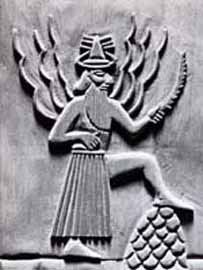
Shamash or Sama, was the common Akkadian name of the sun-god in Babylonia and Assyria, corresponding to Sumerian Utu.
The name signifies perhaps "servitor," and would thus point to a secondary position occupied at one time by this deity. Both in early and in late inscriptions Sha-mash is designated as the "offspring of Nannar," i.e. of the moon-god, and since, in an enumeration of the pantheon, Sin generally takes precedence of Shamash, it is in relationship, presumably, to the moon-god that the sun-god appears as the dependent power.
Such a supposition would accord with the prominence acquired by the moon in the calendar and in astrological calculations, as well as with the fact that the moon-cult belongs to the nomadic and therefore earlier, stage of civilization, whereas the sun-god rises to full importance only after the agricultural stage has been reached.
The two chief centres of sun-worship in Babylonia were Sippar, represented by the mounds at Abu Habba, and Larsa, represented by the modern Senkerah. At both places the chief sanctuary bore the name E-barra (or E-babbara) "the shining house" a direct allusion to the brilliancy of the sun-god. Of the two temples, that at Sippara was the more famous, but temples to Shamash were erected in all large centres such as Babylon, Ur, Mari, Nippur and Nineveh.
The attribute most commonly associated with Shamash is justice. Just as the sun disperses darkness, so Shamash brings wrong and injustice to light. Hammurabi attributes to Shamash the inspiration that led him to gather the existing laws and legal procedures into a code, and in the design accompanying the code the king represents himself in an attitude of adoration before Shamash as the embodiment of the idea of justice.
Several centuries before Hammurabi, Ur-Engur of the Ur dynasty (c. 2600 BC) declared that he rendered decisions "according to the just laws of Shamash."
It was a logical consequence of this conception of the sun-god that he was regarded also as the one who released the sufferer from the grasp of the demons. The sick man, therefore, appeals to Shamash as the god who can be depended upon to help those who are suffering unjustly. This aspect of the sun-god is vividly brought out in the hymns addressed to him, which are, therefore, among the finest productions in the entire realm of Babylonian literature.
It is evident from the material at our disposal that the Shamash cults at Sippar and Larsa so overshadowed local sun-deities elsewhere as to lead to an absorption of the minor deities by the predominating one. In the systematized pantheon these minor sun-gods become attendants that do his service. Such are Bunene, spoken of as his chariot driver, whose consort is Atgi-makh, Kettu ("justice") and Mesharu ("right"), who are introduced as servitors of Shamash.
Other sun-deities, as Ninurta and Nergal, the patron deities of important centres, retained their independent existence as certain phases of the sun, Ninib becoming the sun-god of the morning and of the spring time, and Nergal the sun-god of the noon and of the summer solstice, while Shamash was viewed as the sun-god in general.
Together with Sin and Ishtar, Shamash forms a second triad by the side of Anu, Enlil and Ea. The three powers, Sin, Shamash and Ishtar, symbolized the three great forces of nature, the sun, the moon and the life-giving force of the earth.
At times, instead of Ishtar, we find Adad, the storm-god, associated with Sin and Shamash, and it may be that these two sets of triads represent the doctrines of two different schools of theological thought in Babylonia which were subsequently harmonized by the recognition of a group consisting of all four deities.
The consort of Shamash was known as A. She, however, is rarely mentioned in the inscriptions except in combination with Shamash.
Sin - Nanna
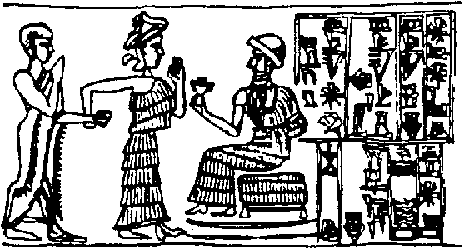
Nanna is a god in Sumerian mythology, god of the moon, son of Enlil and Ninlil. His sacred city was Ur. The name Nanna is Sumerian for "illuminater".
He was named Sin in Babylonia and Assyrian and was also worshipped by them in Harran. Sin had a beard made of lapis lazuli and he rode on a winged bull.
His wife was Ningal ('Great Lady') who bore him Utu 'Sun' and Inana and in some texts Ishkur.
His symbols are the crescent moon, the bull, and a tripod (which may be a lamp-stand).The two chief seats of Sin's worship were Ur in the south, and Harran to the north. The cult of Sin spread to other centres, at an early period, and temples to the moon-god are found in all the large cities of Babylonia and Assyria.
He is commonly designated as En-zu = "lord of wisdom". This attribute clings to him through all periods. During the period (c. 2600-2400 BC) that Ur exercised a large measure of supremacy over the Euphrates valley, Sin was naturally regarded as the head of the pantheon. It is to this period that we must trace such designations of Sin as "father of the gods", "chief of the gods", "creator of all things", and the like. We are justified in supposing that the cult of the moon-god was brought into Babylonia by Semitic nomads from Arabia.
The moon-god is par excellence the god of nomadic peoples. The moon being their guide and protector at night when, during a great part of the year, they undertake their wanderings. This is just as the sun-god is the chief god of an agricultural people. The cult once introduced would tend to persevere, and the development of astrological science culminating in a calendar and in a system of interpretation of the movements and occurrences in the starry heavens would be an important factor in maintaining the position of Sin in the pantheon.
Sin's chief sanctuary at Ur was named E-gish-shir-gal = "house of the great light". His sanctuary at Harran was named E-khul-khul = "house of joys". On seal-cylinders he is represented as an old man with flowing beard with the crescent as his symbol. In the astral-theological system he is represented by the number 30, and the planet Venus and his daughter by the number 15. This 30 probably refers to the average number of days (correctly around 29.53) in a lunar month as measured between successive new moons.
The "wisdom" personified by the moon-god is likewise an expression of the science of astrology in which the observation of the moon's phases is so important a factor. The tendency to centralize the powers of the universe leads to the establishment of the doctrine of a triad consisting of Sin, Shamash and Ishtar, personifying the moon and the sun and the earth as the life-force.
Tiamat - Leviathan
Tiamat is a primeval monster/goddess in Babylonian and Sumerian mythology, and a central figure in the Enûma Elish creation epic. John C. L. Gibson, in the Ugaritic glossary of Canaanite Myths and Legends, notes that "tehom" appears in the Ugaritic texts, c. 14001200 BCE, simply meaning the "sea". Such a depersonalized Tiamat (the -at ending makes her feminine) is "The Deep" (Hebrew tehom), present at the beginning of the book of Genesis.
Apsu (or Abzu) fathered upon Tiamat the Elder gods Lahmu and Lahamu, the grandparents of Anu and Ea. Lahmu and Lahamu, in turn, were the parents of the heavens (Anshar) and the earth (Kishar). Tiamat was the "shining" goddess of salt water who roared and smote in the chaos of original creation. She and Apsu filled the cosmic abyss with the primeval waters. She is "Ummu-Hubur who formed all things".
The god Enki (later Ea), believing correctly that Apsu was planning to murder the younger gods, slew him. This angered Tiamat, whereupon she fashioned monsters to battle the gods. These were her own offspring, sea-serpents of terrifying size, storms and fish-men and scorpion-men.
Tiamat had the Tablets of Destiny, and in the primordial battle she gave them to Kingu, the god she had chosen for her lover. But Anu (replaced by Marduk, the son of Ea, in the late version that has survived) overcame Kingu and then her, armed with the winds and a net and an invincible spear.
Sumerian Demi-Gods
Enkidu
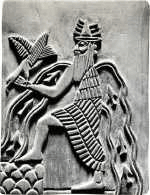
Enkidu appears in Sumerian mythology as a mythical wild-man raised by animals; his beast-like ways are finally tamed by a courtesan named Shamhat. Later he adventures with Gilgamesh until his death in the Epic of Gilgamesh. Older sources sometimes transliterate his name as Enkimdu, Eabani or Enkita.
Enkidu is the quintessential savage man in the beginning of the epic:
"The whole of his body was hairy and his (uncut) locks were like a woman's or the hair of the goddess of grain. Moreover, he knew nothing of settled fields or human beings and was clothed (in skins) like a deity of flocks."
Enkidu roamed with the beasts of the wilderness. He protected the animals, destroying the hunters' traps, and lurked around the watering holes to protect the game. These actions were much to the chagrin of a local trapper. The trapper went to King Gilgamesh to ask for help. Gilgamesh offered the advice "Trapper, go back, take with you a harlot, a child of pleasure ... he will embrace her and the game of the wilderness will surely reject him." The trapper did what he was told, and hired the harlot Shamhat to corrupt the wild man. Enkidu was immediately taken with the harlot and bedded her. Over six days of lust, Enkidu is tainted by the harlot. The animals begin to avoid him, the bond he once shared with them having been broken. Now "he scattered the wolves, he chased away the lions" and the herders could lie down in peace, for Enkidu was now their watchman.
|
|
|
|
|
After the abandonment of his animal brethren, Enkidu is introduced to a pastoralist way of life. He works for the trapper and shepherds, hunting and killing the animals he once served. Soon he grows restless, looking for a greater challenge.
Shamhat tells of a great king in the city Uruk (Gilgamesh) and says, too, that he would be a worthy challenge for Enkidu. Gilgamesh is surprised by Enkidu. The two wrestle fiercely for sometime, until suddenly Gilgamesh gains the upper hand and throws Enkidu to the ground. Knowing his defeat, Enkidu praises Gilgamesh and both swear an oath of friendship. For the remainder of the epic they cohabit, as lovers according to some interpretations.
Enkidu later in the Epic of Gilgamesh
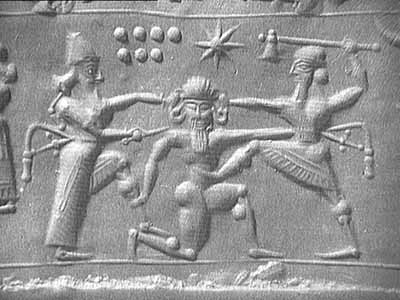
Gilgamesh and Enkidu killing Humbaba
Enkidu assists Gilgamesh in his fight against Humbaba, the guardian monster of the Cedar forest. Contrary to Enkidu's conscience, he cooperates in killing the defeated Humbaba. Afterwards, he again assists his companion Gilgamesh in slaying the Bull of Heaven, which the gods have sent as reprisal. The goddess Ishtar demands that the pair should pay for its destruction. Shamash argues to the other gods to spare both of them, but could only save Gilgamesh. The gods pass judgment that Enkidu had no justification for fighting the Bull of Heaven and was interfering with the will of the gods. Enkidu then is overcome by a severe illness. Near death, he has visions of a gloomy afterlife, and curses the trapper and the harlot for civilizing him, the act which lead him to this doom.
Gilgamesh mourns over the body of Enkidu for several desperate days. In a vivid line repeated in the epic, Gilgamesh only allows his friend to be buried after a maggot falls out of the corpse's nose. Gilgamesh's close observation of rigor mortis and the slow decomposition of Enkidu's body provides the hero with the impetus for his quest for eternal life, and his visit to Utnapishtim.
There is another non-canonical tablet in which Enkidu journeys into the underworld, but many scholars consider the tablet to be a sequel or add-on to the original epic.
Historical Analysis
In many ways, Enkidu's transformation may represent the seductive power of the Mesopotamian city-states. His origins upon the steppe and his life as a companion of the wild beast suggests the hunter-gatherers living on the fringes of the territory of southern Iraq's early farmers. His subsequent transformation and acceptance of life in Uruk becomes a mythologized account of their slow approach to and assimilation within the boundaries of horticultural civilization.
On a more personal level, the taming of Enkidu by the harlot could be symbolic of the influence of the ego and material desires on the individual, leading them away from a natural, and into an artificial existence.
Gilgamesh
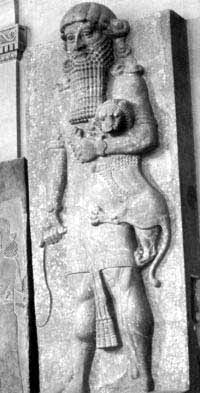
According to the Sumerian king list, Gilgamesh was the fifth king of Uruk (Early Dynastic II, first dynasty of Uruk), the son of Lugalbanda. Legend has it that his mother was Ninsun, a goddess.According to another document, the so-called History of Tummal, Gilgamesh, and eventually his son Urlugal, rebuilt the sanctuary of the goddess Ninlil, located in Tummal, a block of the Nippur city.
Ninlil, first called Sud, is the daughter of Nammu and An in Sumerian mythology. She lived in Dilmun with her family. Raped by her brother and future husband Enlil, she conceived a boy, Nanna, the future moon god. After her death, she became the goddess of the air, like Enlil.
In the Epic of Gilgamesh it is often said that Gilgamesh ordered the creation of the legendary walls of Uruk. In historical age, Sargon of Akkad claimed to have destroyed these walls to prove his military force.
Fragments of an epic text found in Me-Turan (actual Tell Haddad) inform that Gilgamesh at the end of his life was buried under the waters of a river. The people of Uruk deviated the flow of the Euphrates, river crossing Uruk, with the purpose to bury the corpse of the dead king in the bed of the river.
Despite the lack of direct evidence, most scholars do not object to consideration of Gilgamesh as a historical figure, particularly after inscriptions were found confirming the historical existence of other figures associated with him: kings Enmebaragesi and Aga of Kish. If Gilgamesh was a historical king, he probably reigned in about the 26th century BC. Some of the earliest Sumerian texts spell his name as Bilgamesh.
In most texts, Gilgamesh is written with the determinative for divine beings (DINGIR), but there is no evidence for a contemporary cult, and the Sumerian Gilgamesh myths suggest the deification was a later development (unlike the case of the Akkadian god-kings). Historical or not, Gilgamesh became a legendary protagonist in the Epic of Gilgamesh.
Geshtinasnna
In sumerian mythology she is the daughter of Enki and Ninhursag. When her brother Dumuzi died, Geshtinanna lamentated days and nights. After his death, she visited him in the underworld with Inanna, and was allowed to take his place there for six months out of the year. Her time in the underworld and her periodic emergence from it are linked with her new divine authority over the autumn vines and wine.
Gugalanna
The Bull of Heaven, according to Kramer he is Ereshkigal's husband. After Gilgamesh spurned Inanna, she sends the Bull of Heaven to terrorize Erech.
Huwawa
Guardian of the cedar of the heart in the the "Land of the living", Huwawa has dragon's teeth, a lion's face, a roar like rushing flood water, huge clawed feet and a thick mane. He lived there in a cedar house. He appears to have attacked Gilgamesh, Enkidu and company when they felled that cedar. They then come upon Huwawa and Gilgamesh distracts him with flatery, then puts a nose ring on him and binds his arms. Huwawa grovels to Gilgamesh and Enkidu and Gilgamesh almost releases him. Enkidu argues against it and when Huwawa protests, he decapitates Huwawa.
Sumerian Religion
Sumerian Mythology
Sumer Wikipedia
ShareThis
SUMER INDEX
ANCIENT CIVILIZATIONS INDEX
ALPHABETICAL INDEX OF ALL FILES
CRYSTALINKS HOME PAGE
PSYCHIC READING WITH ELLIE
2012 THE ALCHEMY OF TIME
|
|
|
|
|
Ishtar es una diosa mesopotámica que fue adorada por los babilonios, los sumerios (con el nombre de Innana) y los fenicios (con el nombre de Astarté). Representaba el amor, la fertilidad y la vida y la podemos encuadrar en el prototipo de Diosa Madre. Se la supone hija del dios de la luna, Sin, y de la Luna misma, Nannar. Su consorte es el dios Tammuz, que a su vez era su hermano. Tiene un carácter astral, ya que ha sido identificada con el Sol, la Luna, el planeta Venus y las estrellas formando constelaciones. Su símbolo, de hecho, es una estrella de ocho puntas, y la palabra estelar viene derivada de su nombre.
La leyenda por la que Ishtar es especialmente conocida es aquella en la que desciende a los infiernos para buscar a su esposo. Ereshkigal, su hermana, era quien lo retenía allí, ya que tenía poder sobre la vida y la muerte. Tuvo que atravesar siete puertas, perdiendo una prenda de ropa cada vez que atravesaba una, hasta que llegó al infierno, totalmente desnuda. Ereshkigal la mató y la colgó de un clavo.
Debido a la ausencia de Ishtar, la Tierra comenzó a languidecer. Papsukal, el sirviente de Ishtar, les contó lo sucedido a los dioses, quien lograron de volverle la vida y sacarla de los infiernos. La única condición que tuvo que cumplir fue permitir que Tammuz pasara seis meses en el infierno, durante los cuales ella lamentaba su pérdida. Se cree que en esta leyenda tiene su origen la Danza de los Siete Velos.
El culto de Ishtar estaba relacionado con la prostitución sagrada, mediante la cual se revelaban los Grands Misterios de la Diosa. Las prostitutas de Ishtar se ofrecían a aquellos que quisieran experimentar a la diosa a través de ellas a cambio de una suma de dinero para el templo. Hay que precisar que en aquellos tiempos, este tipo de prostitución no tenía las connotaciones que le vemos hoy día. Era un orgullo ser una prostituta del Templo de Ishtar, no sólo para la mujer que la ejercía, sino para toda su familia, ya que implicaba un servicio directo a la diosa y una actividad mística y religiosa que ayudaba a la prosperidad de la ciudad.
Leer más: http://www.historiaymitologia.com/2010/06/ishtar.html#ixzz1gMLHNhqE Under Creative Commons License: Attribution Non-Commercial No Derivatives |
|
|
|
|
Mateo
24:24 Porque se levantarán falsos Cristos, y falsos profetas, y harán grandes señales y prodigios, de tal manera que engañarán, si fuere posible, aun a los escogidos.
24:25 Ya os lo he dicho antes.
24:26 Así que, si os dijeren: Mirad, está en el desierto, no salgáis; o mirad, está en los aposentos, no lo creáis.
24:27 Porque como el relámpago que sale del oriente y se muestra hasta el occidente, así será también la venida del Hijo del Hombre. (La luna llena sale en oriente y se pone en occidente. El primero de AV, en contexto a un solsticio de verano, tenemos SOL Y LUNA EN PLENITUD)
24:28 Porque dondequiera que estuviere el cuerpo muerto, allí se juntarán las águilas.
24:29 E inmediatamente después de la tribulación de aquellos días, el sol se oscurecerá, y la luna no dará su resplandor, y las estrellas caerán del cielo, y las potencias de los cielos serán conmovidas.
24:30 Entonces aparecerá la señal del Hijo del Hombre en el cielo; y entonces lamentarán todas las tribus de la tierra, y verán al Hijo del Hombre viniendo sobre las nubes del cielo, con poder y gran gloria.
24:31 Y enviará sus ángeles con gran voz de trompeta, y juntarán a sus escogidos, de los cuatro vientos, desde un extremo del cielo hasta el otro.
24:32 De la higuera aprended la parábola: Cuando ya su rama está tierna, y brotan las hojas, sabéis que el verano está cerca.
20. Mateo 24:32: De la higuera aprended la parábola: Cuando ya su rama está tierna, y brotan las hojas, sabéis que el VERANO está cerca.
21. Marcos 13:28: De la higuera aprended la parábola: Cuando ya su rama está tierna, y brotan las hojas, sabéis que el VERANO está cerca.
22. Lucas 21:30: Cuando ya brotan, viéndolo, sabéis por vosotros mismos que el VERANO está ya cerca.
24:33 Así también vosotros, cuando veáis todas estas cosas, conoced que está cerca, a las puertas. (PUERTA DE ISTAR. JUSTAMENTE EL SOLSTICIO DE VERANO ERA EN EL PAGANISMO LA FIESTA DE ISTAR. ORION ESTA EN CONJUNCION CON EL SOL EN EL SOLSTICIO)24:34 De cierto os digo, que no pasará esta generación hasta que todo esto acontezca. 24:35 El cielo y la tierra pasarán, pero mis palabras no pasarán. (CIELO Y TIERRA ES UNA REFERENCIA SUBLIMINAL A LA ESCALERA DE JACOB, OSEA LA ALQUIMIA ENTRE EL CIELO Y LA TIERRA. CASA DE DIOS Y PUERTA DEL CIELO)24:36 Pero del día y la hora nadie sabe, ni aun los ángeles de los cielos, sino sólo mi Padre. 24:37 Mas como en los días de Noé, así será la venida del Hijo del Hombre.

Puerta de Ishtar, Pergamonmuseum, Berlín
The Ishtar Gate from Babylon; Puerta de Istar; שער עשתר ; بوابة عشتار;
Three names that appear more often as a sacred group of three are … Ninki - (later became Ishtar) the mother Enki - (later became Namakh) the father Marduk the son
This Trinity representation evolved a little further. In the ancient ruins in Syria centuries later after the belief had been passed down many generations, long before The Christ, some names were altered for unknown reasons. Perhaps in the same way the name Yeshua, a Hebrew Aramaic name was altered to become Jesus, a more acceptable Roman name after someone of the authority like Emperor Constantine had altered it. The same three Sun gods from Sumer now as follows… from left to right… Marduk the son on a lion, Enki… now as Namakh the father still retaining the bull of Taurus, and Ninki… now as Ishtar on another lion.
24:38 Porque como en los días antes del diluvio estaban comiendo y bebiendo, casándose y dando en casamiento, hasta el día en que Noé entró en el arca, 24:39 y no entendieron hasta que vino el diluvio y se los llevó a todos, así será también la venida del Hijo del Hombre.
|
|
|
|
|
ESTATUA DE LA LIBERTAD ES ISTAR-EN LUCAS 16 EN CONTEXTO A LA PARABOLA DEL RICO Y DE LAZARO APARECE ISTAR-COMPARE CON APOCALIPSIS 22:16 EN CONTEXTO A JESUCRISTO Y EL LUCERO DE LA MAÑANA
ANALOGIA ESOTÉRICA ENTRE LA PARABOLA DEL RICO Y DE LAZARO CON EL UNGIMIENTO DE BETANIACapítulo 12: Juan 12
1 Seis días antes de la Pascua, Jesús se fue a Betania, donde estaba Lázaro, a quien Jesús había resucitado de entre los muertos.
2 Le dieron allí una cena. Marta servía y Lázaro era uno de los que estaban con él a la mesa.
3 Entonces María, tomando una libra de perfume de nardo puro, muy caro, ungió los pies de Jesús y los secó con sus cabellos. Y la casa se llenó del olor del perfume.
4 Dice Judas Iscariote, uno de los discípulos, el que lo había de entregar:
5 "¿Por qué no se ha vendido este perfume por trescientos denarios y se ha dado a los pobres?"
6 Pero no decía esto porque le preocuparan los pobres, sino porque era ladrón, y como tenía la bolsa, se llevaba lo que echaban en ella.
7 Jesús dijo: "Déjala, que lo guarde para el día de mi sepultura.
8 Porque pobres siempre tendréis con vosotros; pero a mí no siempre tendréis."
9 Gran número de judíos supieron que Jesús estaba allí y fueron, no sólo por Jesús, sino también por ver a Lázaro, a quien había resucitado de entre los muertos.
10 Los sumos sacerdotes decidieron dar muerte también a Lázaro,
11 porque a causa de él muchos judíos se les iban y creían en Jesús.LUCAS 16
16 La ley y los profetas hasta Juan: desde entonces el reino de Dios es anunciado, y quienquiera se esfuerza á entrar en él.
17 Empero más fácil cosa es pasar el cielo y la tierra, que frustrarse un tilde de la ley. (En el unico mandamiento de los diez que figura la expresion "cielo y tierra" es en el cuarto. Nuestro Señor Jesucristo en forma esoterica nos esta expresando la CONSPIRACION CONTRA EL CUARTO MANDAMIENTO MEDIANTE EL FALSO CALENDARIO)
18 Cualquiera que repudia á su mujer, y se casa con otra, adultera: y el que se casa con la repudiada del marido, adultera.
19 "Era un hombre rico que vestía de púrpura y lino, y celebraba todos los días espléndidas fiestas.
20 Y uno pobre, llamado Lázaro, que, echado junto a su portal, cubierto de llagas,
21 deseaba hartarse de lo que caía de la mesa del rico... pero hasta los perros venían y le lamían las llagas. (En el ungimiento de Betania esta Lazaro sentado en una mesa en una cena. Aqui hay un NEXO CON MARDOQUEO EN CONTEXTO A LA PUERTA)
22 Sucedió, pues, que murió el pobre y fue llevado por los ángeles al seno de Abraham. Murió también el rico y fue sepultado. (En el ungimiento de Betania tambien se hace referencia a los pobres cuando Juda habla de los mismos en un claro contexto abrahamico ya que la FIESTA DE LOS TABERNACULOS EN VIRGO es en ese contexto. Recordemos tambien que dicho ungimiento al ser 8 dias antes de la Pascua tambien fue en shabbat lunar ya que cayo en un octavo día del primer mes NISSAN)
23 "Estando en el Hades entre tormentos, levantó los ojos y vio a lo lejos a Abraham, y a Lázaro en su seno. (Vuelve la parabola a hacer REFERENCIA A ABRAHAM Y LÁZARO. Observen tambien que ELEAZAR, que es el nombre hebreo equivalente a LAZARO es el que le busca la NOVIA A ISAAC con 10 camellos con un fuerte mensaje esotérico con referencia a la carga y al shabbat. Esto esta en los primeros capitulos de Génesis)
24 Y, gritando, dijo: "Padre Abraham, ten compasión de mí y envía a Lázaro a que moje en agua la punta de su dedo y refresque mi lengua, porque estoy atormentado en esta llama." (La expresión PADRE ABRAHAM demuestra la fuerte connotasión con el pacto abrahamico de esta parabola y obviamente del UNGIMIENTO DE BETANIA)
25 Pero Abraham le dijo: "Hijo, recuerda que recibiste tus bienes durante tu vida y Lázaro, al contrario, sus males; ahora, pues, él es aquí consolado y tú atormentado.
26 Y además, entre nosotros y vosotros se interpone un gran abismo, de modo que los que quieran pasar de aquí a vosotros, no puedan; ni de ahí puedan pasar donde nosotros."
27 "Replicó: "Con todo, te ruego, padre, que le envíes a la casa de mi padre,
28 porque tengo cinco hermanos, para que les dé testimonio, y no vengan también ellos a este lugar de tormento."
29 Díjole Abraham: "Tienen a Moisés y a los profetas; que les oigan."
30 El dijo: "No, padre Abraham; sino que si alguno de entre los muertos va donde ellos, se convertirán."
31 Le contestó: "Si no oyen a Moisés y a los profetas, tampoco se convencerán, aunque un muerto resucite." (Obviamente cuando se habla de muertos es claro que es con REFERENCIA A LA MUERTE ESPIRITUAL PRINCIPALMENTE. ESTO DEMUESTRA QUE EN EL UNGIMIENTO DE BETANIA HUBO UNA RESURRECCIÓN ESPIRITUAL DE CRISTO INCREIBLEMENTE TAMBIEN ENGANCHADO CON EL PACTO EDÉNICO Y EL PACTO ABRAHÁMICO. TODO ESTO TAMBIEN DEMUESTRA QUE MARIA DE BETANIA ERA LA MISMA MARIA MAGDALENA ESPOSA DE CRISTO)
ABRAHAM DESEABA UNA NOVIA PARA ISAAC El relato nos cuenta cómo Abraham hace que su siervo más antiguo, Eliezer, le prometa que iría a la tierra y parentela de Abraham para encontrar una novia para su hijo, Isaac. Abraham deseaba que esta novia parra Isaac fuese de su parentela y no de las hijas de los Cananeos que vivían en ese tiempo, Génesis 24:2. Examinemos los personajes de la historia y lo que representan espiritualmente. Entonces, examinaremos también las características de la novia que fue elegida para Isaac.
- Abraham es un cuadro de Dios Padre.
- Eliezer es un cuadro espiritual del Espíritu Santo. Eliezer = Diccionario de Strong 461 = "Dios de ayuda." Eliezer = criado de Abraham (Génesis 24:2 = Génesis 15:2)
- Rebeca es un cuadro espiritual de la Novia de Cristo.
- Isaac es un cuadro espiritual de Jesús el Novio.
 En este cuadro espiritual, podemos ver que Dios el Padre desea encontrar una Novia para Jesús, el Mesías. Para hacerlo, Dios envió a Su Santo Espíritu para preparar un pueblo que le encuentre y contraiga matrimonio con Jesús, el Novio. LAS CARACTERÍSTICAS ESPIRITUALES DE LA NOVIA
 Ahora escudriñemos las características espirituales de la Novia, examinando el matrimonio bíblico entre Isaac y Rebeca.
- Se albergaron en una casa que estaba preparada para ellos, (Génesis 24:23,25,31).
- La esposa es tomada de entre su parentela, (Génesis 24:4).
- La novia para Isaac era Rebeca, la hija de Betuel, el hijo de Milcam mujer de Nacor (Génesis 22:20-23, 24:15).
- Génesis 24:16 = "Doncella" = (5291) palabra hebrea "Naará".
- La mujer debe estar dispuesta a seguir, (Génesis 24:8).
- Génesis 24:12,14 = bondad (2617).
- Génesis 24:21 = viaje =(1870) = "Halaj" = "camino".
- El siervo tomó 10 camellos, (Génesis 24:10).
- Los camellos se arrodillaron al lado de un "pozo de agua" al tiempo en que "las mujeres salen a sacar agua", (Génesis 24:11).
- Rebeca llevaba un "cántaro" de agua, (Génesis 24:14-18,20,43,45,46).
- Abraham hizo un gran banquete el día que Isaac fue destetado, (Génesis 21:8).
- La novia para Isaac se le asocia con la promesa de Dios a Abraham, (Génesis 24:7).
RESURRECCION DE LAZARO COMO TIPO DEL GRIAL
 |
|
|
|
|
Mateo
12:1 En aquel tiempo iba Jesús por los sembrados en un día de reposo; y sus discípulos tuvieron hambre, y comenzaron a arrancar espigas y a comer. (Espigas esta interrelacionado con Pentecostes. Cristo siempre interrelaciona el shabbat con PENTECOSTES. Esto tambien confirma que el verdadero pentecostes es en EXODO 32 LUEGO DE EXODO 31 EN QUE SE HACE REFERENCIA AL SHABBAT)
12:2 Viéndolo los fariseos, le dijeron: He aquí tus discípulos hacen lo que no es lícito hacer en el día de reposo.
12:3 Pero él les dijo: ¿No habéis leído lo que hizo David, cuando él y los que con él estaban tuvieron hambre;
12:4 cómo entró en la casa de Dios, y comió los panes de la proposición, que no les era lícito comer ni a él ni a los que con él estaban, sino solamente a los sacerdotes?
12:5 ¿O no habéis leído en la ley, cómo en el día de reposo los sacerdotes en el templo profanan el día de reposo, y son sin culpa? (Cristo esta haciendo referencia esoterica a la LEY DEL MANA que estaba prohibido levantarlo en sabado)
12:6 Pues os digo que uno mayor que el templo está aquí.
12:7 Y si supieseis qué significa: Misericordia quiero, y no sacrificio, no condenaríais a los inocentes;
12:8 porque el Hijo del Hombre es Señor del día de reposo.
12:9 Pasando de allí, vino a la sinagoga de ellos.
12:10 Y he aquí había allí uno que tenía seca una mano; y preguntaron a Jesús, para poder acusarle: ¿Es lícito sanar en el día de reposo?
12:11 El les dijo: ¿Qué hombre habrá de vosotros, que tenga una oveja, y si ésta cayere en un hoyo en día de reposo, no le eche mano, y la levante? (Raquel significa oveja)
12:12 Pues ¿cuánto más vale un hombre que una oveja? Por consiguiente, es lícito hacer el bien en los días de reposo.
12:13 Entonces dijo a aquel hombre: Extiende tu mano. Y él la extendió, y le fue restaurada sana como la otra.
12:14 Y salidos los fariseos, tuvieron consejo contra Jesús para destruirle.
12:15 Sabiendo esto Jesús, se apartó de allí; y le siguió mucha gente, y sanaba a todos,
12:16 y les encargaba rigurosamente que no le descubriesen;
12:17 para que se cumpliese lo dicho por el profeta Isaías, cuando dijo:
12:18 He aquí mi siervo, a quien he escogido; Mi Amado, en quien se agrada mi alma; Pondré mi Espíritu sobre él, Y a los gentiles anunciará juicio.
12:19 No contenderá, ni voceará, Ni nadie oirá en las calles su voz.
12:20 La caña cascada no quebrará, Y el pábilo que humea no apagará, Hasta que saque a victoria el juicio.
12:21 Y en su nombre esperarán los gentiles.
12:22 Entonces fue traído a él un endemoniado, ciego y mudo; y le sanó, de tal manera que el ciego y mudo veía y hablaba.
12:23 Y toda la gente estaba atónita, y decía: ¿Será éste aquel Hijo de David?
12:24 Mas los fariseos, al oírlo, decían: Este no echa fuera los demonios sino por Beelzebú, príncipe de los demonios.
12:25 Sabiendo Jesús los pensamientos de ellos, les dijo: Todo reino dividido contra sí mismo, es asolado, y toda ciudad o casa dividida contra sí misma, no permanecerá.
12:26 Y si Satanás echa fuera a Satanás, contra sí mismo está dividido; ¿cómo, pues, permanecerá su reino?
12:27 Y si yo echo fuera los demonios por Beelzebú, ¿por quién los echan vuestros hijos? Por tanto, ellos serán vuestros jueces.
12:28 Pero si yo por el Espíritu de Dios echo fuera los demonios, ciertamente ha llegado a vosotros el reino de Dios.
12:29 Porque ¿cómo puede alguno entrar en la casa del hombre fuerte, y saquear sus bienes, si primero no le ata? Y entonces podrá saquear su casa.
12:30 El que no es conmigo, contra mí es; y el que conmigo no recoge, desparrama.
12:31 Por tanto os digo: Todo pecado y blasfemia será perdonado a los hombres; mas la blasfemia contra el Espíritu no les será perdonada.
12:32 A cualquiera que dijere alguna palabra contra el Hijo del Hombre, le será perdonado; pero al que hable contra el Espíritu Santo, no le será perdonado, ni en este siglo ni en el venidero.
12:33 O haced el árbol bueno, y su fruto bueno, o haced el árbol malo, y su fruto malo; porque por el fruto se conoce el árbol.
12:34 ¡Generación de víboras! ¿Cómo podéis hablar lo bueno, siendo malos? Porque de la abundancia del corazón habla la boca.
12:35 El hombre bueno, del buen tesoro del corazón saca buenas cosas; y el hombre malo, del mal tesoro saca malas cosas.
12:36 Mas yo os digo que de toda palabra ociosa que hablen los hombres, de ella darán cuenta en el día del juicio.
12:37 Porque por tus palabras serás justificado, y por tus palabras serás condenado.
12:38 Entonces respondieron algunos de los escribas y de los fariseos, diciendo: Maestro, deseamos ver de ti señal.
12:39 El respondió y les dijo: La generación mala y adúltera demanda señal; pero señal no le será dada, sino la señal del profeta Jonás.
12:40 Porque como estuvo Jonás en el vientre del gran pez tres días y tres noches, así estará el Hijo del Hombre en el corazón de la tierra tres días y tres noches.
12:41 Los hombres de Nínive se levantarán en el juicio con esta generación, y la condenarán; porque ellos se arrepintieron a la predicación de Jonás, y he aquí más que Jonás en este lugar. 12:42 La reina del Sur se levantaráen el juicio con esta generación, y la condenará; porque ella vino de los fines de la tierra para oír la sabiduría de Salomón, y he aquí más que Salomón en este lugar. 12:43 Cuando el espíritu inmundo sale del hombre, anda por lugares secos, buscando reposo, y no lo halla. 12:44 Entonces dice: Volveré a mi casa de donde salí; y cuando llega, la halla desocupada, barrida y adornada. 12:45 Entonces va, y toma consigo otros siete espíritus peores que él, y entrados, moran allí; y el postrer estado de aquel hombre viene a ser peor que el primero. Así también acontecerá a esta mala generación. 12:46 Mientras él aún hablaba a la gente, he aquí su madre y sus hermanos estaban afuera, y le querían hablar. 12:47 Y le dijo uno: He aquí tu madre y tus hermanos están afuera, y te quieren hablar. 12:48 Respondiendo él al que le decía esto, dijo: ¿Quién es mi madre, y quiénes son mis hermanos? 12:49 Y extendiendo su mano hacia sus discípulos, dijo: He aquí mi madre y mis hermanos. 12:50 Porque todo aquel que hace la voluntad de mi Padre que los cielos, ése es mi hermano, y hermana, y madre. |
|
|
|
|
| Acts 20:16 |
For Paul had determined to sail by Ephesus, because he would not spend the time in Asia: for he hasted, if it were possible for him, to be at Jerusalem the day of Pentecost. |
| 2 Chronicles 26:20 |
And Azariah the chief priest, and all the priests, looked upon him, and, behold, he was leprous in his forehead, and they thrust him out from thence; yea, himself hasted also to go out, because the LORD had smitten him. |
| 1 Corinthians 16:8 |
But I will tarry at Ephesus until Pentecost. |
| Acts 2:1 |
And when the day of Pentecost was fully come, they were all with one accord in one place. |
| 1 Samuel 31:4 |
Then said Saul unto his armourbearer, Draw thy sword, and thrust me through therewith; lest these uncircumcised come and thrust me through, and abuse me. But his armourbearer would not; for he was sore afraid. Therefore Saul took a sword, and fell upon it. |
| Psalms 48:5 |
They saw it, and so they marvelled; they were troubled, and hasted away. |
| Psalms 104:7 |
At thy rebuke they fled; at the voice of thy thunder they hasted away. |
| Job 31:5 |
If I have walked with vanity, or if my foot hath hasted to deceit; |
| Exodus 5:13 |
And the taskmasters hasted them, saying, Fulfil your works, your daily tasks, as when there was straw. |
| 1 Kings 20:41 |
And he hasted, and took the ashes away from his face; and the king of Israel discerned him that he was of the prophets. |
| 2 Kings 9:13 |
Then they hasted, and took every man his garment, and put it under him on the top of the stairs, and blew with trumpets, saying, Jehu is king. |
| Genesis 24:20 |
And she hasted, and emptied her pitcher into the trough, and ran again unto the well to draw water, and drew for all his camels. |
| 1 Samuel 25:42 |
And Abigail hasted, and arose and rode upon an ass, with five damsels of hers that went after her; and she went after the messengers of David, and became his wife. |
| 2 Samuel 19:16 |
And Shimei the son of Gera, a Benjamite, which was of Bahurim, hasted and came down with the men of Judah to meet king David. |
| Esther 6:12 |
And Mordecai came again to the king's gate. But Haman hasted to his house mourning, and having his head covered. |
| Esther 6:14 |
And while they were yet talking with him, came the king's chamberlains, and hasted to bring Haman unto the banquet that Esther had prepared. |
| Genesis 18:7 |
And Abraham ran unto the herd, and fetcht a calf tender and good, and gave it unto a young man; and he hasted to dress it. |
| 1 Samuel 28:24 |
And the woman had a fat calf in the house; and she hasted, and killed it, and took flour, and kneaded it, and did bake unleavened bread thereof: |
| Numbers 35:20 |
But if he thrust him of hatred, or hurl at him by laying of wait, that he die; |
| 2 Samuel 23:6 |
But the sons of Belial shall be all of them as thorns thrust away, because they cannot be taken with hands: |
| Isaiah 13:15 |
Every one that is found shall be thrust through; and every one that is joined unto them shall fall by the sword. |
| 1 Samuel 25:23 |
And when Abigail saw David, she hasted, and lighted off the ass, and fell before David on her face, and bowed herself to the ground, |
| Joshua 8:19 |
And the ambush arose quickly out of their place, and they ran as soon as he had stretched out his hand: and they entered into the city, and took it, and hasted and set the city on fire. |
| Genesis 24:18 |
And she said, Drink, my lord: and she hasted, and let down her pitcher upon her hand, and gave him drink. |
| Jeremiah 51:4 |
Thus the slain shall fall in the land of the Chaldeans, and they that are thrust through in her streets. |
|
|
|
|
|
|
|
|
| Tehilim, el renacer de la humanidad |
| |
|
El renacer de la humanidad
En Shavuot, según una muy arraigada costumbre, se lee la Meguilat Ruth (rollo de Rut).
Rut, la moabita, que adoptó la Tora de alma y corazón, constituye el ejemplo más apropiado para recordar en la festividad de Shavout, día de la entrega de la Tora de D's a Israel.
Otra razón que se da para leer Rut en este día es que esta conversa fue la bisabuela del Rey David, quien nació -y también falleció-en Shavuot.
Así está escrito, "Este es el libro de las generaciones del hombre", (Gen. V:1). Mostró D's todas las futuras generaciones a Adán. Le mostró, entre todas, a David quien debía vivir sólo tres horas...Y Adán dijo, "que 70 años de mi vida sean traspasados a esta alma"... Y agregó, "¡Soberano del Universo! ¡A éste otórgale soberanía y cantos de alabanza que perduren los setenta años de su vida, para que pueda cantar ante Ti!" (Yaikut Shimoní Ber. 41)
Soberanía y canto:
El hombre: un mundo en miniatura
De todas las extraordinarias maravillas que D's creó, el hombre es la más sublime, porque es un verdadero microcosmos, un mundo en miniatura compuesto de todos los elementos existentes en la creación.
De todo corazón humano surge un eco de los rugidos valientes del león, conjuntamente con el suave balido del tímido cordero. Por los tejidos del hombre corre una vena fuerte y resistente de hierro, entrelazada con una hebra de caña blanda y flexible. Todos los reinos -animal, vegetal y mineral- se encuentran dentro del hombre. Sin embargo, además de todos los elementos materiales de la tierra, éste posee un intelecto desarrollado y un espíritu sagrado, bienes del cielo. Es por ello que el hombre en sí es verdaderamente un pequeño universo.
¿Y cuál es el objetivo propio del universo? los mismos Salmos afirman lo siguiente: "Los cielos cuentan la gloria de D's, y el firmamento anuncia la obra de Sus Manos". (Salmos XIX:2)
El mundo entero es un coro que canta canciones alegres. En el "Perek Hashirim" ("Capítulo de Cantos"), los sabios describen los cantos que toda criatura entona para el Creador; ya sea el poderoso sol o la pequeña hormiga, como el melodioso pájaro cantor o la rana que croa, todos cantan uno o más versos de la Biblia como un canto de alabanza a D's. La tierra Le declara que Le pertenece en toda su integridad. Las estrellas proclaman que D's es el único anfitrión celestial. Y el caballo dice que todos deben mirar a D's como él mira a su amo.
¿Qué mensaje tenemos oculto en estas canciones? Es muy simple: se canta alabanza a D's cuando cada una de las partes de Su creación realiza a la perfección la tarea que se le ha asignado. Toda criatura que cumple su función es un verdadero instrumento de precisión. Juntas forman una orquesta cósmica.
Sin embargo, no basta con tener grandes artistas para crear una orquesta sinfónica. Necesitan un maestro calificado para armonizar la multitud de tonos existentes y obtener un resultado de una belleza extrema. Si cada músico improvisa según su parecer sólo se logrará ruido, no música.
D's colocó a Adán en el estrado y le asignó el cargo de director de la orquesta y coro del universo. Todos los elementos de la creación deben obedecer a su batuta. Se entregó a Adán una pauta e instrucciones sobre cómo emplear cada elemento en su momento y lugar adecuado.
Los Salmos dicen lo siguiente sobre la misión del hombre: "Le hiciste señorear sobre las obras de Tus Manos, todo lo pusiste bajo sus pies" (Salmos VIII:7). La soberanía del hombre no es un mero privilegio sino una obligación. Hay que balancear, ajustar, guiar y conseguir que todas las fuerzas divergentes del mundo se unan en una sinfonía sublime en alabanza a D's. Adán estaba dotado de un gran talento para cumplir su misión, descrita en el Midrash como "soberanía y canto".
El vidente
350 años después del Sinaí comenzó la Era de Samuel (Shmuel). Ya un año antes del nacimiento de Samuel, "una voz celestial" anunciaba la llegada de esta gran alma. En la época de Samuel la profecía se propagaba por toda la tierra de Israel gracias a sus discípulos que aprendían bajo su tutela a acercarse cada vez más a D's. El versículo siguiente describe claramente esa nueva visión del mundo que surge en esos días: "Antiguamente en Israel, cualquiera que iba a consultar a D's decía así: "Vayamos a ver el vidente"; porque en esos tiempos al profeta se le llamaba vidente" (Samuel IX:9)
El propio Samuel aceptó ese título y se presentó ante Saúl (Shaúl) con estas palabras: "Soy el vidente". (Ibid. IX:19)
Sin embargo, nuestros sabios nos cuentan que D's encontró reparo a la forma en que Samuel se describía. ¿Era él quien realmente veía? ¿No era D's acaso quien le mostraba el camino? Samuel debería haber aclarado lo que él sabía en su corazón y que esperaba que sus oyentes lo comprendiesen: "Yo soy aquel que ve lo que D's le indica" (Harav Gifter).
"El Todopoderoso, Bendito Sea, dijo a Samuel: "¿Te consideras vidente? ¡Te mostraré algo que no podrás ver!" ¿Cuándo sucedió eso? ¡Cuando D's mandó a Samuel a ungir a David!" (Yaikut Shimoní ibid.)
¡No hay duda que Samuel sabía muy bien que la fuente de los poderes del vidente no es la vista sino el oído! ¡Aquel que no escucha no ve! Samuel también sabía que D's había desechado a Saúl, al primer rey a quien había ungido porque se había dejado atraer y engañar por sus ojos. Saúl vio los hermosos animales de Amalek y los guardó para futuras ofrendas en vez de aniquilarlos como D's se los había ordenado. (I Samuel XV:9-15)
"Y Samuel dijo: ¿Se complace Hashem (El Señor, literalmente "El Nombre", se refiere al impronunciable nombre de D's) tanto con las ofrendas quemadas y sacrificios como en que se obedezca la voz de Hashem? Ciertamente, la obediencia es mejor que el sacrificio, y el prestar atención que la gordura de los carneros" (ibid. XV:22)
La semilla de Ruth
D's desechó la Casa de Saúl y ordenó a Samuel que ungiese a un nuevo rey. Condujo al profeta hacia una familia que había luchado toda su vida por recobrar la pureza primitiva de Adán: La familia de Yishay, hijo de 'Oved, a su vez hijo de Ruth.
'Oved era hijo de Ruth:
"Se le llamó 'Oved (literalmente serviente) por-que servía a D's con todo su corazón. Y de 'Oved nació Yishay a quien también se llamó serpiente" (II Samuel XVII:25). Pasaron muchos días antes de que el Ángel de la Muerte pudiese encontrar una causa para llevarse el alma de Yishay, porque ese hombre estaba libre de toda culpa y pecado. D's recordó a la "serpiente" que indujo a Adán y Eva a comer el fruto del Árbol de la Sabiduría. Debido a ese pecado, todos los hombres deberán morir, y esa fue la única causa para la muerte del virtuoso Yishay" (Targum; Ruth IV:21-22).
Samuel llegó entonces a casa de Yishay y fue presentado a sus siete hijos. Al ver a Eliab, el mayor, el vidente exclamó, muy impresionado: "De cierto delante de Hashem está su ungido". (Samuel XVI:6)
Eliab parecía ser un aristócrata de noble linaje, un líder con una disciplina y autocontrol perfectos. Pero lo que Samuel no lograba ver era que Eliab tenía un carácter violento con ataques de rabia incontrolables. (Pesajim 66b; Midrash Shemuel 19).
"Y El Señor dijo a Samuel: no te fijes en su apariencia o su gran estatura, porque lo he desechado. Las cosas no son como el hombre las ve, porque el hombre sólo ve lo que tiene ante sus ojos, mientras que Hashem mira dentro del corazón". (Ibid. v.7)
Descalificó uno por uno a los siete hijos de Yishay. Sin embargo, éste tenía un octavo hijo, quien era un simple pastor. Nadie lo quería. Tampoco lo conocían bien. Como no parecía estar destinado a rey, ni siquiera lo habían invitado a dar la bienvenida al vidente. Pero ahora que D's había rechazado a sus hermanos se le mandó a llamar a los pastoreos. "Era pelirrojo y tenía unos ojos hermosos" (v.12)
Samuel quedó muy preocupado al ver por primera vez a David. Se dijo: "¡Este joven es un asesino tan cruel como Esav! (Esaú, el cruel hermano del patriarca Yaákob-Jacob)". Pero el Todopoderoso, Bendito Sea, calmó sus temores con las palabras siguientes: "¡No! Este es distinto porque tiene ojos hermosos. Esav mata para satisfacer sus propios deseos, mientras que David aniquila a sus enemigos aconsejado y guiado por el Sanhedrín (quienes son los ojos de la comunidad)". (Bereshit Rabbá LXVI:3)
Samuel ciertamente no se había equivocado en su primera impresión de David. Este, por naturaleza, tenía tendencia a la violencia, pero había refinado su carácter gracias a las lecciones de los Sabios. ¡Y David consultó a Hashem! (Samuel II 11:1)
David siempre consultaba a D's sobre el camino a seguir. No confió nunca en su propia sabiduría e ingenio. Era una de las cualidades que Saúl no poseía; actuaba por iniciativa propia (Malbim ibid).
Sin embargo, el rey Saúl tenía un temperamento suave y sumiso, nunca se iba a los extremos, mientras que David ardía de pasiones que sólo lograba aplacar con gran esfuerzo (Or Ha-jayim Hakadosh, Deuteronomio-Debarim-XXXI:1).
Por naturaleza, David tenía tendencia a ser cruel. No obstante, sólo dejaba ver ese rasgo de su carácter al luchar contra idólatras o herejes, porque con sus hermanos judíos era muy bondadoso (Rambam, Shemoná Perakim 7).
Fue el único hombre a quien D's asignó la tarea de restaurar la visión de la nación: "Hashem dijo: ¡Levántate y úngelo porque éste es el elegido!" (Samuel I XVI:12)
Salmo 126
1 Cántico gradual, cuando el Eterno hiciere tornar la cautividad de Sión, seremos como los que sueñan.
2 Entonces nuestra boca se henchirá de risas; y nuestra lengua de alabanzas. Entonces dirán entre las gentes: grandes cosas ha hecho el Eterno con estos.
3 Grandes cosas ha hecho el Eterno con nosotros, estuvimos alegres.
4 Has volver nuestra cautividad, oh Eterno, como los arroyos del Neguev.
5 Los que sembraron con lágrimas, con regocijo segarán.
6 Irá andando y llorando el que lleva la preciosa semilla. Mas volverá con regocijo trayendo sus gavillas.
Esta canción describe el ascenso más sublime de la nación judía: su ascenso desde las profundidades del exilio. La redención final parecerá un sueño, porque será tan maravillosa que trascenderá todas las expectativas de Israel. David compuso y cantó este salmo como una profecía de acontecimientos que sucederían mucho después de su muerte. Por ello este Salmo está escrito como si fuese dicho por los cautivos de Babilonia.
El retorno de los cautivos
Introducción
Se cuenta que un emperador de Roma se expresó diciendo. ¡Qué difícil es para un ovejita pastar en medio de setenta lobos!. ¡Qué grande es el pastor que la cuida! replicó el sabio.
La redención de los judíos de Babilonia decretada por Ciro rey de Persia fue considerada a los ojos de esa generación como uno de los milagros más grandes de la historia de nuestro pueblo.
Significaba el renacimiento de todo un pueblo anonadado por el cautiverio, que volverá a disfrutar de una vida independiente en su propio país.
La noticia del retomo les tomó tan de sorpresa que casi no podían creerlo, les parecía un sueño.
Y en verdad ¿no es todo esto un sueño? ¿No es el sueño maravilloso de un prisionero de celda que sale a la libertad?
No solamente los judíos redimidos, sino también los gentiles, sus opresores, exclamaban con admiración. ¡D's ha hecho grandes cosas con estos!
David compuso este salmo inspirado con el Ruaj Hakodesh (Espíritu Santo o Profético), para que mucho después de su muerte, lo cantaran los retornados de Babilonia y más tarde, a la llegada del Mesías, cuando D's reunirá a los dispersos de los cuatro confines del universo.
Existe la costumbre de recitar este salmo antes de Birkat Hamazón (Bendición después de las comidas con pan) solicitando el retorno de la cautividad de Sión.
Según el comentarista RADAK- Rabi David Kimhi, el salmista exhorta al pueblo a rezar por la paz de Jerusalém porque la ciudad estaba siempre en problemas. Por su situación estratégica, Jerusalém era el paso obligado de los grandes ejércitos expedicionarios de Roma, Grecia y Asiria hacia Egipto, y recíprocamente de los ejércitos egipcios hacia el Asia menor.
Interpretación
1-“CUANDO EL ETERNO HICIERE TORNAR (...)" De nuevo en este salmo la atención del salmista se concentra en el milagro del retomo de los cautivos de Sión. Aquellos que iban a la vanguardia caminaban como en un sueño entre las naciones gentiles que exclamaban llenas de asombro: D's ha hecho con éstos, grandes cosas. Y en verdad así fue: D's hizo con nosotros grandes milagros. Nos parecía un sueño; no creíamos que era una realidad.
2/6- "ENTONCES NUESTRA BOCA SE HENCHIRÁ DE RISAS (...)" Ahora el salmista eleva su oración para la reunión de los que se encuentran dispersos en países lejanos y la restauración de sus riquezas individuales y nacionales, tal como ocurrió a la salida de Egipto que los hicimos Birjush Gadol, todos vendrán con sus fortunas que serán tan provechosas, como los arroyos de agua lo son para la tierra seca del Neguev, donde escasea el precioso líquido.
Esos arroyos cambiarán la tierra árida del desierto en un jardín florido, los granjeros sembrarán sus granos con lágrimas, pero a la hora de la siega cederá el llanto para dar lugar a una gran alegría.
Es en el exilio donde hemos sembrado; es en Sión que cosecharemos; es el judío quien lleva la semilla; es Israel quien recogerá las gavillas.
Este salmo se opone al salmo 137, "Junto a los ríos de Babilonia", en el cual se describe el descenso de los judíos hacia el exilio. Se dice el salmo 137 antes de Bircat HaMazón (rezo para después de las comidas) en días de semana, para recordarnos constantemente la destrucción de nuestro Templo, aunque nuestros cuerpos estén saciados y cómodos en el exilio. El salmo 126, por el contrario, se recita antes de Bircat HaMazón en Shabbat y días festivos. Como estas festividades sagradas permiten a los judíos exiliados y oprimidos vislumbrar su gloria y elevación futuras, deben decir este cántico por la restauración que nos indica que Hashem hará retornar a los cautivos de Sión.
Articulo extraído de la revista El Kolel con la autorización de su editor
|
|
|
|
|
|
¡No hay duda que Samuel sabía muy bien que la fuente de los poderes del vidente no es la vista sino el oído! ¡Aquel que no escucha no ve! Samuel también sabía que D's había desechado a Saúl, al primer rey a quien había ungido porque se había dejado atraer y engañar por sus ojos. Saúl vio los hermosos animales de Amalek y los guardó para futuras ofrendas en vez de aniquilarlos como D's se los había ordenado. (I Samuel XV:9-15)
"Y Samuel dijo: ¿Se complace Hashem (El Señor, literalmente "El Nombre", se refiere al impronunciable nombre de D's) tanto con las ofrendas quemadas y sacrificios como en que se obedezca la voz de Hashem? Ciertamente, la obediencia es mejor que el sacrificio, y el prestar atención que la gordura de los carneros" (ibid. XV:22)
La semilla de Ruth
D's desechó la Casa de Saúl y ordenó a Samuel que ungiese a un nuevo rey. Condujo al profeta hacia una familia que había luchado toda su vida por recobrar la pureza primitiva de Adán: La familia de Yishay, hijo de 'Oved, a su vez hijo de Ruth.
'Oved era hijo de Ruth:
"Se le llamó 'Oved (literalmente serviente) por-que servía a D's con todo su corazón. Y de 'Oved nació Yishay a quien también se llamó serpiente" (II Samuel XVII:25). Pasaron muchos días antes de que el Ángel de la Muerte pudiese encontrar una causa para llevarse el alma de Yishay, porque ese hombre estaba libre de toda culpa y pecado. D's recordó a la "serpiente" que indujo a Adán y Eva a comer el fruto del Árbol de la Sabiduría. Debido a ese pecado, todos los hombres deberán morir, y esa fue la única causa para la muerte del virtuoso Yishay" (Targum; Ruth IV:21-22).
Samuel llegó entonces a casa de Yishay y fue presentado a sus siete hijos. Al ver a Eliab, el mayor, el vidente exclamó, muy impresionado: "De cierto delante de Hashem está su ungido". (Samuel XVI:6)
Eliab parecía ser un aristócrata de noble linaje, un líder con una disciplina y autocontrol perfectos. Pero lo que Samuel no lograba ver era que Eliab tenía un carácter violento con ataques de rabia incontrolables. (Pesajim 66b; Midrash Shemuel 19).
"Y El Señor dijo a Samuel: no te fijes en su apariencia o su gran estatura, porque lo he desechado. Las cosas no son como el hombre las ve, porque el hombre sólo ve lo que tiene ante sus ojos, mientras que Hashem mira dentro del corazón". (Ibid. v.7)
Descalificó uno por uno a los siete hijos de Yishay. Sin embargo, éste tenía un octavo hijo, quien era un simple pastor. Nadie lo quería. Tampoco lo conocían bien. Como no parecía estar destinado a rey, ni siquiera lo habían invitado a dar la bienvenida al vidente. Pero ahora que D's había rechazado a sus hermanos se le mandó a llamar a los pastoreos. "Era pelirrojo y tenía unos ojos hermosos" (v.12)
Samuel quedó muy preocupado al ver por primera vez a David. Se dijo: "¡Este joven es un asesino tan cruel como Esav! (Esaú, el cruel hermano del patriarca Yaákob-Jacob)". Pero el Todopoderoso, Bendito Sea, calmó sus temores con las palabras siguientes: "¡No! Este es distinto porque tiene ojos hermosos. Esav mata para satisfacer sus propios deseos, mientras que David aniquila a sus enemigos aconsejado y guiado por el Sanhedrín (quienes son los ojos de la comunidad)". (Bereshit Rabbá LXVI:3)
Samuel ciertamente no se había equivocado en su primera impresión de David. Este, por naturaleza, tenía tendencia a la violencia, pero había refinado su carácter gracias a las lecciones de los Sabios. ¡Y David consultó a Hashem! (Samuel II 11:1)
David siempre consultaba a D's sobre el camino a seguir. No confió nunca en su propia sabiduría e ingenio. Era una de las cualidades que Saúl no poseía; actuaba por iniciativa propia (Malbim ibid).
Sin embargo, el rey Saúl tenía un temperamento suave y sumiso, nunca se iba a los extremos, mientras que David ardía de pasiones que sólo lograba aplacar con gran esfuerzo (Or Ha-jayim Hakadosh, Deuteronomio-Debarim-XXXI:1).
Por naturaleza, David tenía tendencia a ser cruel. No obstante, sólo dejaba ver ese rasgo de su carácter al luchar contra idólatras o herejes, porque con sus hermanos judíos era muy bondadoso (Rambam, Shemoná Perakim 7).
Fue el único hombre a quien D's asignó la tarea de restaurar la visión de la nación: "Hashem dijo: ¡Levántate y úngelo porque éste es el elegido!" (Samuel I XVI:12)
http://www.judaismohoy.com/article.php?article_id=1487 |
|
|
|
|
Mateo 7:15: Guardaos de los falsos profetas, que vienen a vosotros con vestidos de ovejas, pero por dentro son LOBOs rapaces.
10. Mateo 10:16: He aquí, yo os envío como a ovejas en medio de LOBOs; sed, pues, prudentes como serpientes, y sencillos como palomas.
11. Lucas 10:3: Id; he aquí yo os envío como corderos en medio de LOBOs.
12. Juan 10:12: Mas el asalariado, y que no es el pastor, de quien no son propias las ovejas, ve venir al LOBO y deja las ovejas y huye, y el LOBO arrebata las ovejas y las dispersa.
13. Hechos 20:29: Porque yo sé que después de mi partida entrarán en medio de vosotros LOBOs rapaces, que no perdonarán al rebaño.
1. Génesis 49:27: Benjamín es LOBO arrebatador; A la mañana comerá la presa, Y a la tarde repartirá los despojos.
RAQUEL
Nombre hebreo (Rahel) que significa "oveja". Para un pueblo nómada y pastor como los israelitas, éste era un gran nombre. Era una expresión de ternura el sobrenombre de oveja. La bellísima historia de amor que envuelve este nombre ha hecho que desde la primera Raquel hace ya cerca de tres mil años, hasta el presente, nunca haya dejado de llevarse.
Raquel
es la esposa amada de Jacob. Viajó éste a Mesopotamia, a ver a su tío Labán. Raquel, la hija menor de éste, salió a su encuentro. Jacob se enamoró de ella en cuanto la vio. Fue un flechazo. Propuso a Labán quedarse a trabajar siete años para él a cambio de que se la concediese como esposa. Aceptó Labán, y se quedó con él Jacob, haciendo prosperar sus rebaños. Al cabo de los siete años, en la ceremonia de la boda el padre le entregó la mujer cubierta con el velo nupcial (que no era transparente como ahora). Y tras la ceremonia, ya anochecido, la introdujo en su tienda. Al día siguiente, con la luz del sol, supo Jacob que con quien se había casado no era con Raquel, sino con su hermana Lía. Protestó Jacob ante su tío, pero éste le dijo que su obligación de padre era casar antes a la hija mayor. Tuvo que aguantarse Jacob. No podía ya repudiar a Lía. Le ofreció a su tío por tanto, trabajar otros siete años por conseguir a Raquel. Y así lo hizo. Al cabo de ese tiempo, Raquel pasó a ser la segunda mujer de Jacob, ella que era la primera en su corazón. No lo tuvo fácil Raquel con su hermana Lía. Los celos le complicaron mucho las cosas. El corazón de Jacob estaba por Raquel y el de Raquel por Jacob. Para colmo resultó que tuvo que llorar su esterilidad durante varios años, hasta que Dios se apiadó de ella y tuvo un hijo, al que llamó José, diciendo: "añádame Yahvé otro hijo". Cuando quiso irse Jacob a su tierra, aún se empeñó Labán en retenerlo otros seis años a cambio de partir con él los rebaños. Vueltos por fin a Palestina, yendo Jacob a ver a su padre Isaac, Raquel, que estaba de nuevo embarazada, sintió por el camino los dolores del parto. Al dar a luz, viendo que se moría, le puso al niño el nombre de Benoni, que significa "hijo de mi dolor". Pero Jacob se lo cambió por el de Benjamín, que significa "hijo de mi diestra". (Su diestra era Raquel). José y Benjamín fueron los preferidos de Jacob. Eso hizo que se levantara la envidia de sus hermanos. Lloró Jacob amargamente a Raquel cuando murió y la enterró cerca de Belén, y le construyó una tumba que todavía hoy se mantiene en pie en memoria de su gran amor. Celebran su onomástica las Raquel el 2 de septiembre, en que se conmemora una santa matrona de este nombre, o el 2 de mayo, en que se conmemora santa Raquel, monja.
Un nombre muy hermoso, el de Raquel, que halaga los oídos y llega al corazón. Tras él hay una recia historia de amor y de vida. La primera historia de amor de nuestra cultura. Es también nombre de flor, conocida por otro nombre como azucena de Güernesey, de un color rojo cereza, que al sol produce la ilusión de presentar puntos dorados. Es delicada, necesita calor en invierno y sólo florece la planta cada tres años. Toda una alegoría del amor verdadero, que no es ni tan fácil ni tan frecuente como nos gustaría. ¡Felicidades, Raquel, por tan bello nombre!
http://www.elalmanaque.com/santoral/julio/17-7-raquel.htm |
|
|
|
|
Busqueda para PUERTA DE BENJAMIN
1. Jeremías 37:13: Y cuando fue a la puerta de Benjamín, estaba allí un capitán que se llamaba Irías hijo de Selemías, hijo de Hananías, el cual apresó al profeta Jeremías, diciendo: Tú te pasas a los caldeos.
2. Jeremías 38:7: Y oyendo Ebed-melec, hombre etíope, eunuco de la casa real, que habían puesto a Jeremías en la cisterna, y estando sentado el rey a la puerta de Benjamín,
3. Ezequiel 48:32: Al lado oriental cuatro mil quinientas cañas, y tres puertas: la puerta de José, una; la puerta de Benjamín, otra; la puerta de Dan, otra.
4. Zacarías 14:10: Toda la tierra se volverá como llanura desde Geba hasta Rimón al sur de Jerusalén; y ésta será enaltecida, y habitada en su lugar desde la puerta de Benjamín hasta el lugar de la puerta primera, hasta la puerta del Angulo, y desde la torre de Hananeel hasta los lagares del rey.
|
|
|
|
|
EL MITO DE LA LUNA LLENA Y EL LOBO TIENE ORIGEN BIBLICO-LA LUNA LLENA/OVEJA ES RAQUEL Y EL LOBO SU HIJO BENJAMIN
Génesis
37:1 Habitó Jacob en la tierra donde había morado su padre, en la tierra de Canaán.
37:2 Esta es la historia de la familia de Jacob: José, siendo de edad de diecisiete años, apacentaba las ovejas con sus hermanos; y el joven estaba con los hijos de Bilha y con los hijos de Zilpa, mujeres de su padre; e informaba José a su padre la mala fama de ellos.
37:3 Y amaba Israel a José más que a todos sus hijos, porque lo había tenido en su vejez; y le hizo una túnica de diversos colores.
37:4 Y viendo sus hermanos que su padre lo amaba más que a todos sus hermanos, le aborrecían, y no podían hablarle pacíficamente.
37:5 Y soñó José un sueño, y lo contó a sus hermanos; y ellos llegaron a aborrecerle más todavía.
37:6 Y él les dijo: Oíd ahora este sueño que he soñado:
37:7 He aquí que atábamos manojos en medio del campo, y he aquí que mi manojo se levantaba y estaba derecho, y que vuestros manojos estaban alrededor y se inclinaban al mío.
37:8 Le respondieron sus hermanos: ¿Reinarás tú sobre nosotros, o señorearás sobre nosotros? Y le aborrecieron aun más a causa de sus sueños y sus palabras.
37:9 Soñó aun otro sueño, y lo contó a sus hermanos, diciendo: He aquí que he soñado otro sueño, y he aquí que el sol y la luna y once estrellas se inclinaban a mí.
37:10 Y lo contó a su padre y a sus hermanos; y su padre le reprendió, y le dijo: ¿Qué sueño es este que soñaste? ¿Acaso vendremos yo y tu madre y tus hermanos a postrarnos en tierra ante ti?
 
Mateo 7:15: Guardaos de los falsos profetas, que vienen a vosotros con vestidos de ovejas, pero por dentro son LOBOs rapaces.
10. Mateo 10:16: He aquí, yo os envío como a ovejas en medio de LOBOs; sed, pues, prudentes como serpientes, y sencillos como palomas.
11. Lucas 10:3: Id; he aquí yo os envío como corderos en medio de LOBOs.
12. Juan 10:12: Mas el asalariado, y que no es el pastor, de quien no son propias las ovejas, ve venir al LOBO y deja las ovejas y huye, y el LOBO arrebata las ovejas y las dispersa.
13. Hechos 20:29: Porque yo sé que después de mi partida entrarán en medio de vosotros LOBOs rapaces, que no perdonarán al rebaño.
1. Génesis 49:27: Benjamín es LOBO arrebatador; A la mañana comerá la presa, Y a la tarde repartirá los despojos.
Génesis
35:1 Dijo Dios a Jacob: Levántate y sube a Bet-el, y quédate allí; y haz allí un altar al Dios que te apareció cuando huías de tu hermano Esaú.
35:2 Entonces Jacob dijo a su familia y a todos los que con él estaban: Quitad los dioses ajenos que hay entre vosotros, y limpiaos, y mudad vuestros vestidos.
35:3 Y levantémonos, y subamos a Bet-el; y haré allí altar al Dios que me respondió en el día de mi angustia, y ha estado conmigo en el camino que he andado.
35:4 Así dieron a Jacob todos los dioses ajenos que había en poder de ellos, y los zarcillos que estaban en sus orejas; y Jacob los escondió debajo de una encina que estaba junto a Siquem.
35:5 Y salieron, y el terror de Dios estuvo sobre las ciudades que había en sus alrededores, y no persiguieron a los hijos de Jacob.
35:6 Y llegó Jacob a Luz, que está en tierra de Canaán (esta es Bet-el), él y todo el pueblo que con él estaba.
35:7 Y edificó allí un altar, y llamó al lugar El-bet-el, porque allí le había aparecido Dios, cuando huía de su hermano.
35:8 Entonces murió Débora, ama de Rebeca, y fue sepultada al pie de Bet-el, debajo de una encina, la cual fue llamada Alón-bacut.
35:9 Apareció otra vez Dios a Jacob, cuando había vuelto de Padan-aram, y le bendijo.
35:10 Y le dijo Dios: Tu nombre es Jacob; no se llamará más tu nombre Jacob, sino Israel será tu nombre; y llamó su nombre Israel.
35:11 También le dijo Dios: Yo soy el Dios omnipotente: crece y multiplícate; una nación y conjunto de naciones procederán de ti, y reyes saldrán de tus lomos.
35:12 La tierra que he dado a Abraham y a Isaac, la daré a ti, y a tu descendencia después de ti daré la tierra.
35:13 Y se fue de él Dios, del lugar en donde había hablado con él.
35:14 Y Jacob erigió una señal en el lugar donde había hablado con él, una señal de piedra, y derramó sobre ella libación, y echó sobre ella aceite.
35:15 Y llamó Jacob el nombre de aquel lugar donde Dios había hablado con él, Bet-el.
35:16 Después partieron de Bet-el; y había aún como media legua de tierra para llegar a Efrata, cuando dio a luz Raquel, y hubo trabajo en su parto.
35:17 Y aconteció, como había trabajo en su parto, que le dijo la partera: No temas, que también tendrás este hijo.
35:18 Y aconteció que al salírsele el alma (pues murió), llamó su nombre Benoni; mas su padre lo llamó Benjamín.
35:19 Así murió Raquel, y fue sepultada en el camino de Efrata, la cual es Belén.
|
|
|
|
|
RELACION DE LA VIRGEN DE LOURDES CON ESTER (13 DE ADAR). En contexto a que la LUNA LLENA, rosh jodesh en luna llena, fue un 29 de ENERO en 1858, la aparicion de la VIRGEN DE LOURDES FUE UN 13 DE ADAR.
Esta Pirámide de cristal, inaugurada en 1989, es obra del arquitecto estadounidense de origen chino Leoh Ming Pei. La pirámide tiene 666 rombos de vidrio y ocupa 1250 metros cuadrados, 35.4 metros de largo y 21.65 metros de altura. Fue una conmoción ciudadana, como la construcción del Centro pompidou. Ahora esa pirámide, además de práctica, a todo el mundo nos parece bonita y adecuada.
http://www.corazones.org/maria/lourdes_bernardita.htm
LAS APARICIONES EN LOURDES
El 11 de febrero, de 1858, era el día elegido para que el cielo se hiciera presente en la tierra. Ese día cambiaría para siempre, no solo la vida de Bernardita, sino que marca el comienzo de una fuente de gracia que ha brotado para toda la humanidad. Fuente que solo crece con el tiempo.
La madre de Bernardita permitió a esta ir con su hermana menor llamada María, y con otra niña, al campo a buscar leña seca. El lugar preferido para recoger leña era un campo que había frente a la gruta. Bernardita por su fragilidad física se quedó atrás.
Las compañeritas habían pasado ya el arroyo, pero Bernardita no se atrevía a meterse al agua porque estaba muy fría. Las demás insistían en que lo hiciese y cuando ella empezó a descalzarse, un ruido muy fuerte, parecido a un viento impetuoso, la obligó a levantar la cabeza y mirar hacia todos los lados.
!Qué es esto!,decía. Las hojas de los árboles estaban inmóviles.
El ruido del viento empezó de nuevo y mas fuerte en la gruta. Y ahí, en el fondo de la gruta, una maravillosa aparición se destacaba delante de ella. En este mismo momento empezaron a sonar las campanas de la Iglesia parroquial y se oía el canto del Ángelus.
Primera Aparición:
Una luz resplandeciente como la del sol, pero dulce y apacible como todo lo que viene del cielo, una Señora prodigiosamente bella se dejó ver por Bernardita. Vestía un traje blanco, brillante y de un tejido desconocido, ajustado al talle con un cinta azul; largo velo blanco caía hasta los pies envolviendo todo el cuerpo. Los pies, de una limpieza virginal y descalzos, parecían apoyarse sobre el rosal silvestre. Dos rosas brillantes de color de oro cubrían la parte superior de los pies de la Santísima Virgen. Juntas sus manos ante el pecho, ofrecían una posición de oración fervorosa; tenia entre sus dedos un largo rosario blanco y dorado con una hermosa cruz de oro.
Todo en Ella irradiaba felicidad, majestad, inocencia, bondad dulzura y paz. La frente lisa y serena, los ojos eran azul celeste llenos de amor y los labios mostraban suavidad y mansedumbre. La Señora parecía saludarla tiernamente mientras se inclinaba ante Bernardita.
Bernardita buscó su rosario (que traía siempre en su bolsillo), haciendo, como para defenderse, la señal de la cruz, pero su mano quedó paralizada. En ese momento la Virgen tomo la cruz del rosario e hizo la señal de la cruz y le dijo a Bernardita que lo hiciera como ella.
En ese momento su brazo paralizado quedó libre. La Señora empezó a pasar las cuentas del rosario entre sus dedos y Bernardita empezó a rezar el suyo. Al terminar, la Virgen le hizo señas con el dedo para que se acercara y entendiendo el brazo, se inclinó dulcemente y sonrió como despidiéndose de Bernardita. ¡La Visión había desaparecido!
Bernardita preguntó a las otras niñas si habían visto algo y al estas responderle que no, les contó su experiencia y les pidió silencio. Pero la hermana de Bernardita se lo contó a su mamá. La madre no le creyó y ordenó a Bernardita que se dejase de imaginaciones y que le estaba prohibido regresar a la gruta.
Esa noche, mientras rezaban el rosario en familia, Bernardita rompió en llantos, repitiendo su invocación favorita: "Oh María sin pecado concebida, rogad por nosotros que acudimos a ti"
|
|
| Eventos astronómicos |
| Luna nueva |
Vienes 15 Enero 1858 5.32' |
| Cuarto creciente |
Vienes 22 Enero 1858 16.50' |
| Luna llena |
Vienes 29 Enero 1858 9.12' |
| Cuarto menguante |
Jueves 7 Enero 1858 0.52' |
| Eclipse |
ningún eclipse de sol |
| ningún eclipse de luna |
|
La hora está en T.U. o sea tiempo universal del meridiano de Greenwich; las fases de la luna son aproximadamente con error máximo de 2m; pero en el eclipse de sol la señalización de la zona visible es solamente indicativa.
|
|
|
|
| Eventos astronómicos |
| Luna nueva |
Sàbado 13 Febrero 1858 22.13' |
| Cuarto creciente |
Domingo 21 Febrero 1858 0.54' |
| Luna llena |
Sàbado 27 Febrero 1858 22.5' |
| Cuarto menguante |
Vienes 5 Febrero 1858 21.21' |
| Eclipse |
ningún eclipse de sol |
| Eclisse parziale di Luna
Sàbado 27 Febrero 1858 22.16'
|
|
La hora está en T.U. o sea tiempo universal del meridiano de Greenwich; las fases de la luna son aproximadamente con error máximo de 2m; pero en el eclipse de sol la señalización de la zona visible es solamente indicativa.
|
|
24. Ester 3:7: En el mes primero, que es el mes de Nisán, en el año duodécimo del rey Asuero, fue echada Pur, esto es, la suerte, delante de Amán, suerte para cada día y cada mes del año; y salió el mes duodécimo, que es el mes de ADAR.
25. Ester 3:13: Y fueron enviadas cartas por medio de correos a todas las provincias del rey, con la orden de destruir, matar y exterminar a todos los judíos, jóvenes y ancianos, niños y mujeres, en un mismo día, en el día trece del mes duodécimo, que es el mes de ADAR, y de apoderarse de sus bienes.
26. Ester 8:12: en un mismo día en todas las provincias del rey Asuero, en el día trece del mes duodécimo, que es el mes de ADAR.
27. Ester 9:1: En el mes duodécimo, que es el mes de ADAR, a los trece días del mismo mes, cuando debía ser ejecutado el mandamiento del rey y su decreto, el mismo día en que los enemigos de los judíos esperaban enseñorearse de ellos, sucedió lo contrario; porque los judíos se enseñorearon de los que los aborrecían.
28. Ester 9:15: Y los judíos que estaban en Susa se juntaron también el catorce del mes de ADAR, y mataron en Susa a trescientos hombres; pero no tocaron sus bienes.
29. Ester 9:17: Esto fue en el día trece del mes de ADAR, y reposaron en el día catorce del mismo, y lo hicieron día de banquete y de alegría.
30. Ester 9:19: Por tanto, los judíos aldeanos que habitan en las villas sin muro hacen a los catorce del mes de ADAR el día de alegría y de banquete, un día de regocijo, y para enviar porciones cada uno a su vecino.
31. Ester 9:21: ordenándoles que celebrasen el día decimocuarto del mes de ADAR, y el decimoquinto del mismo, cada año,
ENERO 1857- LUNA LLENA 10 ENERO
FEBRERO 1857-LUNA LLENA 8 FEBRERO
MARZO 1857-10 MARZO
ABRIL 1857 9 ABRIL
MAYO 9 MAYO
JUNIO 7
JULIO 7
AGOSTO 5
SEPTIEMBRE 4
OCTUBRE 3
NOVIEMBRE 2
DICIEMBRE 1 Y 30
ENERO 29 DE 1858 (DOCEAVO MES)
|
|
|
 Primer Primer
 Anterior
21 a 35 de 215
Siguiente Anterior
21 a 35 de 215
Siguiente Último
Último
|

